JOIN RABBI DOVID HEBER & RABBI SHMUEL SILBER in a Q&A session about the community’s role in shidduchim: What’s working, what’s not, and how we can all be part of the solution.



The Baltimore Community Has The Great Kavod of Welcoming

JOIN RABBI DOVID HEBER & RABBI SHMUEL SILBER in a Q&A session about the community’s role in shidduchim: What’s working, what’s not, and how we can all be part of the solution.



The Baltimore Community Has The Great Kavod of Welcoming

FRIDAY NIGHT
KOL TORAH | 2929 FALLSTAFF RD
Mincha 6:45pm | Drasha after תבש תלבק
BNAI JACOB SHAAREI ZION 6602 PARK HEIGHTS AVENUE
Shacharis 8:45, Drasha After Davening ~11:10am
SHOMREI EMUNAH 6221 GREENSPRING AVENUE
Shiur 5:00pm
Mincha 6:00pm SUBURBAN ORTHODOX 7510 SEVEN MILE LN.
Mincha 7:00pm Drasha during Shalosh Seudos
SUNDAY
MERCAZ TORAH U’TEFILLAH 6504 BAYTHORNE RD.
Shacharis 8:15am
Shiur 8:50am - 9:15am
DERECH CHAIM 6603 PIMLICO RD.
Shiur 9:30am - 10:30am
Hagaon Harav Asher Weiss, shlita, is a towering Torah giant and one of the world’s leading Torah sages and orators. Rav Asher Weiss is the Av Beis Din of Darchei Torah and Rosh Kollel of Bais Medrash Darchei Torah. He serves as the halachic authority for Shaarei Tzedek Hospital and has published 37 sefarim. His weekly shiurim draw thousands from across the Torah world. He teaches in yeshivos and kollelim nationwide and is actively involved in training the next generation of rabbanim, dayanim, and kiruv leaders. Rav Weiss also provides halachic
guidance to Israel’s security services, including the IDF, police, and Mossad.
Through daily public office hours, he offers halachic advice, support, and encouragement to Jews from all walks of life.
Host Committee Jerry Wolasky · Dr. Michael Elman · Dovie Gibber · Shraga Goldenhersh · Dovid Meir Loeb Dr. Elie Portnoy · Yitzie Pretter · Chanina Reischer · Jason Reitberger · Jacob Slone


Lebeinu’s mission is to support and empower parents of children who are struggling with their Yiddishkeit.


Understanding why connection is vital for today’s children and how to apply it in our homes and classrooms

RENOWNED DAYAN, RAV, AND KESHER NAFSHI SPEAKER
Introductory remarks via video by Rabbi Aaron Lopiansky, Shlita
Hosted by Bnos Yisroel | 6300 Park Heights Ave
Tuesday Evening | July 29th | 8:30 PM
Open to community mechanchim, parents, and grandparents

RABBINIC ADVISORS : RABBI YAAKOV HOPFER, RABBI MENACHEM GOLDBERGER, RABBI ZVI TEICHMAN
I’ve written numerous times about my grandparents, R’ Yehuda and Chana Friedman Z”L, and the deep well of inspiration they left behind. Recently, on my grandmother’s yahrtzeit, I listened to a recording of an interview she gave, where a grandchild asked her about her childhood in Mád, Hungary, a small, picturesque town not far from Kerestir. She spoke with such warmth and joy, recalling a home filled with laughter, simplicity, and meaning. She grew up with five sisters and a brother, in a home where Torah and Tefillah were woven into daily life. Her father, my great-grandfather, owned a modest dry goods store, but his real joy was in learning Torah. He instilled in his children a sense of awe for tefillah and learning. Shabbos afternoons weren’t for walks or leisure until each girl had davened Mincha and said “perek.” That was the standard. That was the rhythm of their lives. The highlight of her childhood, she said, was visiting her grandmother. These visits were nothing short of regal. The girls would put on their finest Shabbos clothing, climb into a horse and buggy, and ride off with excitement and anticipation. “It was like going to greet a queen,” my grandmother recalled. When they arrived, their grandmother would line them up, look at each one, and say with pride, “Let me see my beautiful girls,” showering them with love and praise. My grandmother remembered not just the grandeur of those moments, but the way they made her feel — seen, cherished, uplifted. These memories weren’t just precious because of their sweetness; they were sacred because they spoke of a deep, unshakable love that anchored their world.
As we enter the heart of the Nine Days and approach Tishah B’Av, I found myself thinking of that memory as a powerful parable. My grandmother’s visits to her grandmother mirror our own collective memories of
what it once felt like to visit our King in His home. When the Beis Hamikdash stood, we too would dress in our finest and make the journey to Yerushalayim, riding not in a horse and buggy, but with hearts full of longing and awe. We would stand before Hashem, not just with tefillos and karbanos, but with the sense that we were being truly seen; lined up like beloved children before our Father, receiving His brachos, His presence, His smile.
And now, all we have are the stories. Like my grandmother’s vivid recollections of a world long gone, we sit on the floor during these days and remember a time that was so full of Hashem’s love. It’s easy to feel removed from it all, after all, it’s been nearly 2,000 years. But just like her childhood memories never faded, neither has the Jewish neshama forgotten what it’s like to be truly close to Hashem. Deep down, we remember. We remember what it means to be at home.
There’s a story told of a young boy visiting the Kosel on Tishah B’Av. Seeing everyone sitting on the ground crying, he asked his father why they were all so sad. His father explained that this was the place where the Beis Hamikdash once stood, the place where we came close to Hashem, and that because of our sins, it was destroyed. The boy listened quietly, and then, with childlike optimism, said, “But Totty, don’t we believe it will be rebuilt? Look – one wall is already standing! We just need to put up three more!” Sometimes a child can say it best. One wall is still standing – so maybe we’re not as far as we think. If we can remember what it felt like to be loved and to belong, then maybe we’re already on the way back. Wishing you a peaceful Shabbos,
Aaron M. Friedman
Send us your: community events, articles & photos, and mazal tovs to editor@baltimorejewishhome.com to be featured in coming editions!

By: BJLife Newsroom
Chaverim of Baltimore held its annual member appreciation BBQ at the Meadowood Park Pavilion. Volunteers and their families enjoyed delicious BBQ fare, cotton candy, snow cones, and a custom cake. The event also featured a special awards presentation ceremony recognizing outstanding dedication.
So far this year, Chaverim has responded to over 2,700 calls, continuing to be an invaluable resource to the
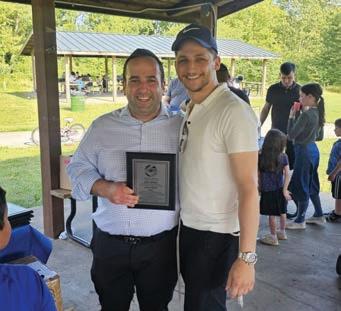
Baltimore community. While many of those calls involve roadside assistance — such as jump starts, tire changes, and car lockouts — Chaverim’s work extends far beyond that. Volunteers regularly assist with house lockouts, gas refills, generator and heater support, traffic control, and even vehicle pull-outs. Their ability to respond to such a wide variety of urgent needs makes Chaverim a trusted, friendly helping hand in times of need.
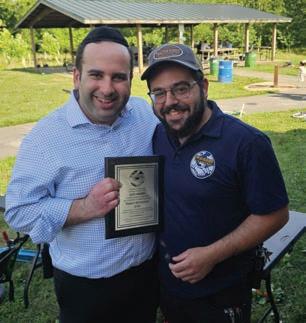
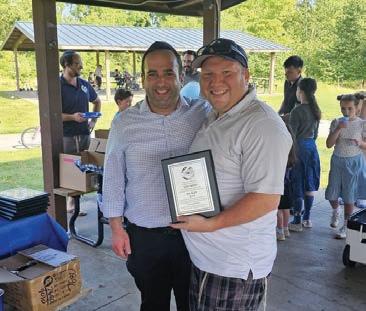
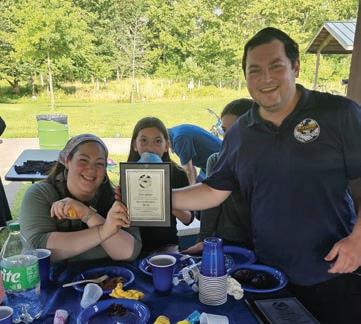
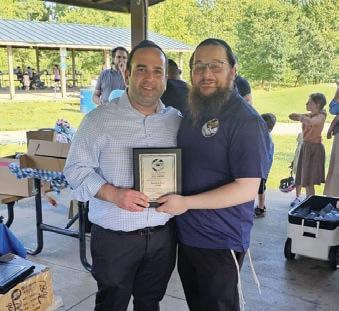

Kollel Nachlas Yosef, one of Baltimore’s newest kollelim, had the privilege of hosting Rav Sholom Tendler, Rabbinic Administrator at the Star-K, for a special pre–Bein HaZmanim shiur this week. Rav Tendler addressed practical kashrus concerns that often arise while traveling or on vacation.
The Kollel, under the dynamic leadership of Rabbi Aron Tendler, is
now completing its inaugural year. Founded in Elul 5784 with 11 yungerleit, it has since grown to 22 dedicated members. Named in memory of the legendary Rav Yosef Tendler zt”l of Mechinas Ner Yisroel, Kollel Nachlas Yosef serves serious yungerleit seeking a vibrant, structured Beis Medrash for one or two sedarim each day.

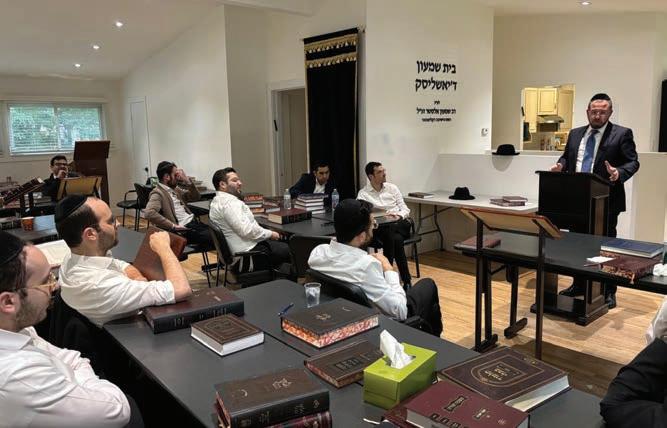
Comfort Year-Round:

Save Big on Energy Costs:
Cut your heating and cooling bills by 30-50% and make your HVAC system work smarter, not harder.
Breathe Better:
Enjoy improved air quality with reduced drafts and outdoor pollutants, creating a healthier living environment.


The Chesed Fund & Project Ezra hosted a practical and free Hagbah Training Workshop in memory of Naomi Devorah Gordon, a”h, giving participants the tools and confidence to perform this vital mitzvah with dignity and strength.
The mitzvah of Hagbah, which involves lifting and displaying the Sefer Torah to the community, is a powerful moment that dates back centuries, reminding us of our connection to the Torah and our community responsibility. Yet, many feel intimidated to step forward for this honor. Recognizing this, the Chesed Fund and Project Ezra sponsored the creation of an exact replica of a Sefer Torah with the only difference being blank parchment. It is designated for this specific purpose, ensuring that there is no halachic issue if it is accidentally mishandled or dropped. In this way, anyone, with or without experience, can easily learn the correct techniques safely and confidently.
Led by Rabbi Ephraim Horowitz, who also runs the Chesed Fund & Project Ezra’s popular annual Shofar Training classes, the workshop welcomed participants ages 13 and up. Everyone received a full-color Hagbah training
manual with clear photos demonstrating grip, stance, lifting, and turning, ensuring that each participant could follow along step-by-step and review the skills as needed. Participants had the opportunity to practice lifting and rolling a Sefer Torah under supervision, transforming hesitation into confidence. What began with a room of cautious faces ended with smiles and laughter as participants felt empowered to take on this sacred mitzvah.
“It’s beautiful to watch people overcome fear and embrace the privilege of lifting the Torah,” Rabbi Horowitz said. “This mitzvah is unique and special, and with the right tools and encouragement, it can be a moment of personal connection to Hashem and the community.”
The Chesed Fund & Project Ezra are committed to continuing this vital work. They will be holding more Hagbah Training Workshops in the near future to enable men and boys to honor the Torah safely and meaningfully. The Torah used is in memory of Rabbi Abraham P. and Rebbetzin Frieda K. Hirmes, a”h, M. Leo and Hannah Storch, a”h, and Frank & Minnie Storch, a”h. For information on future Hagbah and Shofar training
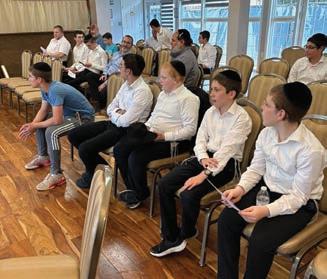

opportunities, or to dedicate a future workshop in memory of a loved one, please contact info@chesedfund.com. May the zechus of this mitzvah and the inspiration it brought be an aliyah for the neshama of Naomi Devorah bas Daniel Noach, a”h.
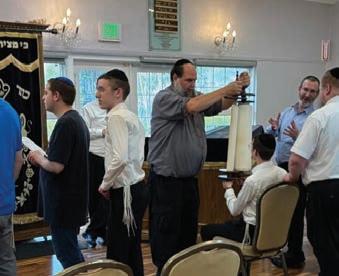
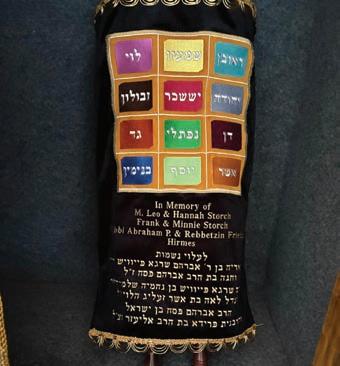
To learn more about the Chesed Fund & Project Ezra’s various and mostly free programs and literature, visit chesedfund.com.
By: BJLife Newsroom
Community member and co-founder of Baltimore based financial planning and CPA Firm, Northbrook Financial, Elliot Pepper, spent this
morning at the Baltimore School of Design to give a financial literacy workshop to Baltimore City YouthWorks participants.

Covering everything from Banking and Budgeting to Investing and Index Funds, it was an empowering experience for all participants and huge step forward in promoting financial literacy with Baltimore’s next generation of leaders!
“Everyone walked away with a sense of accomplishment and motivation to make smart money moves now,” noted Elliot.
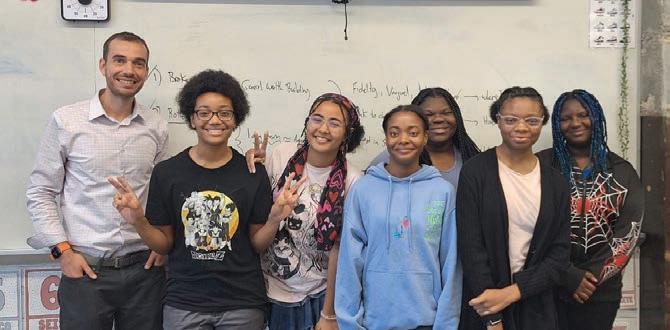

Councilman Schleifer 69 Advanced Security 63, OT
Hariri Keys Massive Schleifer Comeback, Outduels Luchansky
Eitan Hariri hit the tying layup in the final seconds to force overtime, capping a furious Councilman Schleifer in the final minutes and leading to them cruising to another OT win. His outstanding performance nearly outshined the brilliance of Advanced Security’s Yisroel Luchansky, who put his team in position to win with a single game league record 36 points. Luchansky hit 7 3s, several of which were hotly contested.
Hariri scored 21 of his 32 points in the second half as Schleifer tried to chip away at what was a 10 point
Torah Institute of Baltimore was thrilled to host the joyous milestone of their Cheder’s Pre-1A Chumash Siyum!
The siyum celebrated their young talmidim completing the setting of their foundation towards many years of limud haTorah iy”H.
Parents, grandparents, Hanhala and teachers, nearly 500 people, were able to feel the incredible excitement in the room as well as the sincere dedication of the boys.

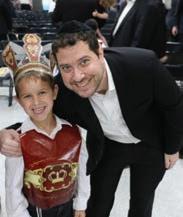
halftime deficit. Advanced Security actually started the game on a massive run, leading 21-5 most of the way through the first half. Schleifer did begin to make headway late in the half, cutting the margin to 30-20.
Avner Shotz had 7 of his 21 points in overtime as he sparked Schleifer in that period with an opening 3, and singlehandedly outscored Advanced Security in the extra period. Advanced got their secondary scoring from sub Moshe Gerhardt, who repeatedly broke down the Schleifer defense in transition and had many of his 20 points on fast breaks.
Councilman Schleifer moves to 5-1 with the win while Advanced Security drops to a tough 1-4 with the loss. Both teams are back in action
next week as the Charm City Ballers season reaches the halfway mark.
Fired Up Promotions 40 M&S Enterprise 37
Fired Up Holds Off M&S Enterprise, Keeps Pace In First Place
Chesky Lewin and Avromi Gartenhaus had 11 points each as Fired Up Promotions squeaked by M&S Enterprise 40-37. This game was hotly contested throughout, as neither team managed a double digit lead at any point. Fired Up led by 7 at half and had a 30-22 advantage midway through the second half, but a 7-0 M&S run cut the deficit to 1 soon thereafter. The final 8 and a half minutes of the game was entirely within a 4 point margin, as both sides struggled to gain any separation or score consistently.
WITS
Watching their faces light up as they marched in, sang, read Pesukim and received their very first Chumash were moments of true nachas for all those present including Preschool Director Mrs. Fleurli Muller, her entire incredible staff, and all those who helped to make this event so special.
This beautiful event marked not just an academic achievement for the boys of Torah Institute, but the beginning of a lifelong connection to Torah and Mitzvos.



Gartenhaus hit a pair of baskets in the final 2 minutes, each giving his team 3 point cushions. The second would prove to be the final basket of the game, as M&S’s tying attempt was wide of the mark. Gartenhaus chipped in 9 rebounds and 3 assists while Lewin continued to be a rebounding machine with 15 and 3 assists of his own.
M&S was led by Jonah Schindelheim with 12 points, while Howie Friedman chipped in 8 rebounds and 5 assists. Howie’s son Avi subbed for M&S and added 9 points and 6 rebounds in the loss, as M&S dropped to 2-2-1. Fired Up is now 5-1 as they keep pace with Councilman Schleifer for 1st place at the halfway mark.
By: BJLife Newsroom
WITS is deeply grateful to Senator Dalya Attar for her advocacy in helping their school secure state funding for a vital campus renovation project.
Thanks to this grant, WITS was able to create three private office spaces where students can now meet confidentially with staff for career guidance, student services, and tech support. The funding also covered essential
furnishings and long-needed storage solutions, significantly enhancing both functionality and comfort.
This renovation has transformed the space — improving the student experience and supporting the work of our dedicated staff. We extend heartfelt thanks to Senator Attar and the State of Maryland for their partnership and commitment in bringing this important project to life

New! Devarim Vol. 1
Devarim-Shoftim New! Sefer Devarim complete in 1 volume
ZICHRON HIRSCH WOLF EDITION OF SEFER DEVARIM


A Phrase-by-Phrase Expanded Elucidation, with Comprehensive Introductions, Annotations, and Insights
Volume dedicated by ROBIN AND WARREN SHIMOFF
Coming Soon: Devarim volume 2
Also available: Sefer Bereishis, Sefer Shemos, Sefer Bamidbar
YOMI SCHEDULES FOR THIS WEEK: YOMI SCHEDULES FOR THIS
ZICHRON AVROHOM EDITION
The Torah: With the Commentary of RABBI SHOMO EPHRAIM OF LUNTSCHITZ Translated, Annotated, and Elucidated
Volume dedicated by YAAKOV AND LEAH ABRAMCZYK
Also available: Shemos volume 1
The Yeshivas Toras Simcha 8th graders had the opportunity to build a model Beis Hamikdash over their first half summer program this year.
In the three short weeks given to the 8th graders, they cut, painted, and modeled with many materials, testing their creative ability in one final project before they would embark to their respective Yeshivos next Zman.
Their Summer Rebbi, Uriel Schwartz commented “The boys worked nonstop on this magnificent project, showcasing their talent and achdus over the past few weeks.”
The list of 8th graders are: Shalom Barth, Netanel Berkowitz, Betzalel Cohen, Nosson Tzvi Fogel, Daniel Herman, Chaim Kimche, Shraga Kraines, Akiva Krohn, Chaim Newmark, Yaakov Paige, Yaakov Tzvi Rayman, Eliezer Saitowitz, and Akiva Asher Shafranovich. Akiva
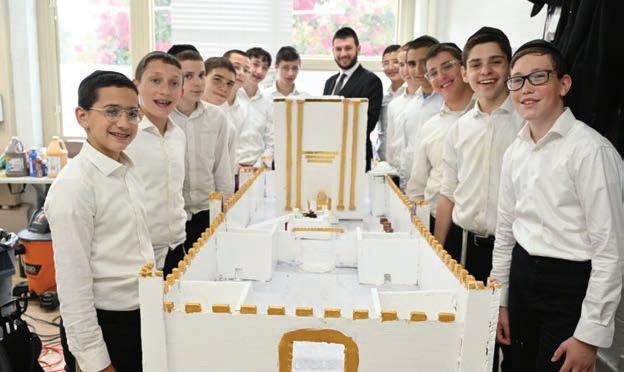

Krohn, commented “At the beginning I thought there was no way we could do this, but here we are!”



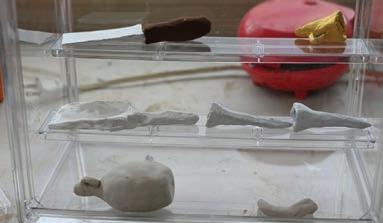
The boys got to showcase their project to their parents and grandparents as well as the entire school to end off their years of growth in YTS.
The halls and campus of Mesivta Kesser Torah were filled with the sounds of singing, dancing, and heartfelt emotion as the Yeshiva celebrated a remarkable and uplifting event — the Hachnasas Sefer Torah of a newly dedicated Sefer Torah, generously gifted by the family of R’ Yaakov Dovid Feldheim z”l, beloved brother of the Rosh Hayeshiva, Rav Tzvi Mordechai Feldheim, shlit”a
The excitement was incredible. Bochurim, Rabbeim, parents, and friends of the Yeshiva gathered in joyous unity as the new Sefer Torah was brought in from Agudas Yisroel of Washington Heights. A particularly moving moment came when the new Sefer Torah was greeted by the Yeshiva’s existing Sifrei Torah — a powerful and symbolic encounter that deeply resonated with all those present.
The dancing was energetic and leibedig, with spirited music and palpable simcha lifting the entire campus. Bochurim danced with passion and pride, expressing their love for Torah and gratitude for the zechus to be part of such a meaningfuxpl event.
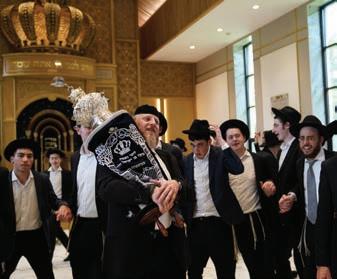
After the Hachnasah, the entire Yeshiva family joined together for a festive seudah, highlighted by divrei Torah and warm words of appreciation for the Feldheim family’s beautiful dedication.
The Rosh Hayeshiva shared personal reflections about his brother, describing how R’ Yaakov Dovid z”l was the one who encouraged him to attend yeshiva in Denver. This formative step ignited his journey in Limmud Ha’Torah, and ultimately led, decades later, to the founding of Mesivta Kesser Torah itself.
The event was a true expression of simchas haTorah and left a lasting impression on all who attended. May

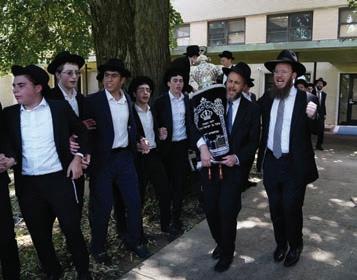
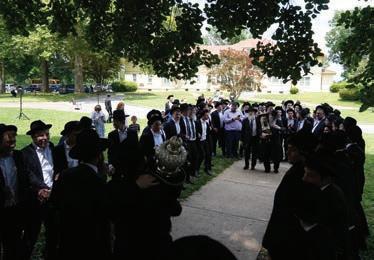
this new Sefer Torah be a source of aliyah for the neshama of R’ Yaakov Dovid z”l and a continued source of inspiration for the talmidim of Mesivta Kesser Torah.
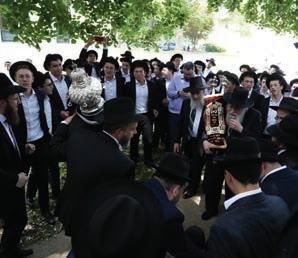
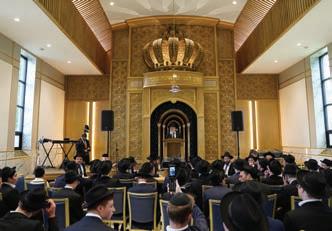





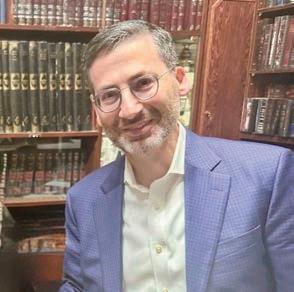
BJH: Avi, thank you for joining us today. To start, could you tell us a little about yourself and your background?
Avi: It’s a pleasure, thank you for having me. I originally hail from Columbus, OH, but my journey to Baltimore started back in 1982 when I came to attend NIRC for high school. After spending some time learning at Mercaz HaTorah in Yerushalayim, I returned to Ner Israel to complete my BTL. I then went on to attend UB Law, and in 2007, I became involved with Clear Title Group in Pikeville, a full-service title company.
Shomrei’s community, and what makes it such a special place for you?
Avi: Shomrei has been a home to me and my family for so many years, and I’ve seen it grow into a community that offers something for everyone. It’s a place where people from all walks of Jewish life come together, whether it’s for the daily minyanim, Torah learning, or one of the many events. Rabbi Binyamin Marwick has been our Rav since 2009, and he has been a tremendous leader for our community. His availability to our members and our community is remarkable—he’s very approachable and makes sure that everyone feels comfortable reaching out to him with any questions or concerns.
Shomrei is really a place where you feel like part of a larger family. The daily minyanim, shiurim, and events are always well-attended, and there’s such a warm, welcoming atmosphere. It’s the cornerstone of our Jewish life here in Baltimore.
Club for Seniors, or children’s Purim Carnival, there’s always something happening at Shomrei. The diversity of events strengthens our sense of community and ensures there’s something for everyone.
BJH: It’s clear that Shomrei is a place with such a broad spectrum of offerings. How do you think this programming has contributed to the community’s growth?
Avi: The programming at Shomrei plays a huge role in creating a community where everyone feels at home. With over 80 minyanim and 50 shiurim a week, people can easily connect with others and find their place, whether it’s for prayer, learning, or socializing. For me personally, the opportunities for Torah learning and spiritual growth have been invaluable, but what really stands out is how inclusive Shomrei is. It’s a place where every person, regardless of their background or level of observance, feels welcome.


I married Judy Gutman in 1995, and we are blessed with four children and two grandchildren. We first came to Shomrei in 1994, and it’s been my shul ever since. I served on the Executive Board at Shomrei for ten years, and in May 2024, I had the honor of becoming the president.
BJH: That’s incredible, Avi. Can you share with us some details about
BJH: Shomrei seems to offer a wide range of programs for its members. Can you tell us about some of the key services and activities available to the community?
Avi: Absolutely. One of the things I love about Shomrei is the incredible range of programming for all ages. We offer a variety of events for men, women, and children— from Torah classes and lectures to social gatherings and holiday celebrations. Whether it’s our Night Kollel Program, Simcha
BJH: It sounds like Shomrei is a HOME for so many people. With that in mind, could you tell us about the fundraising campaign Shomrei is launching, and why it’s so important to help continue making Shomrei a place where “all roads lead”?
Avi: We’re launching this fundraising campaign to help support the essential programs that make Shomrei what it is today. Our daily minyanim, shiurim, and community events are the lifeblood of our syna-
gogue, and we rely on the generosity of our members to keep these programs running. We also want to continue expanding our children’s programming and senior activities to ensure that we’re meeting the needs of every generation in our community.
BJH: Avi, it’s clear that you’re deeply committed to Shomrei’s mission and the community. What message would you like to leave with our readers?
Avi: I would just encourage everyone to recognize the incredible value of Shomrei and the impact it has on our lives. This campaign is a chance to give back to a place that has given so much to each of us. Whether it’s through supporting Torah learning, helping fund the children’s programming, or ensuring that we can continue our daily minyanim, every donation makes a difference. Together, we can help Shomrei continue to be a second home for our entire community.
BJH: Thank you, Avi, for sharing your story and insights. We wish you and the entire Shomrei community much success in this important campaign.
Avi: Thank you, it’s been a pleasure. We really appreciate everyone’s support as we continue to build a community that we can all be proud of.
To contribute to the campaign please visit crowdspark.com/shomreiemunah/ allroads. The campaign is July 27-29.

On Saturday, a popular tourist attraction in Vietnam was the site of disaster. A tourist boat ferrying families around Ha Long Bay was pummeled by a sudden storm. The boat capsized and at least 35 people were killed.
The vessel “Wonder Sea” was carrying 46 passengers and three crew when it capsized because of sudden heavy rain. One resident recalled that “the sky turned dark.” There were “hailstones as
big as toes with torrential rain, thunderstorms and lightning.”
Most of those on board were families visiting from the capital, Hanoi, with more than 20 children among the passengers. Thirty-five bodies had been recovered and 10 people had been rescued by Sunday, police said, with four people still missing.
One of the rescued, a 10-year-old boy, told state media outlet VietnamNet: “I took a deep breath, swam through a gap, dived then swam up. I even shouted for help, then I was pulled up by a boat with soldiers on.”
Torrential rain also lashed northern Hanoi, Thai Nguyen and Bac Ninh provinces on Saturday. Several trees were knocked down in the capital by strong winds.
The storm followed three days of intense heat, with the mercury hitting almost 100 degrees Fahrenheit in some areas.
Ha Long Bay is one of Vietnam’s most popular tourist destinations, with millions of people visiting its blue-green waters and rainforest-topped limestone islands each year.

A neutral third-party panel sided with Chevron in the energy company’s recent legal dispute with Exxon Mobil. The International Chamber of Commerce in Paris, in its Friday ruling, allowed Chevron to move forward with its $53 billion acquisition of Hess. While it disagrees with the decision, Exxon has said it accepts the verdict.
In October 2023, Chevron’s deal with Hess was reached. However, the acquisition process was stopped in its tracks after Exxon maintained that it has a right to bid for Hess’s 30% in the Starbroek offshore block in Guyana, a project that Exxon — which pumps around 650,000
barrels of oil daily in the South American country — has a 45% stake in. Exxon’s attempt to stop Chevron’s total acquisition of Hess was supported by Chinese oil and gas producer Cnooc, which owns a 25% stake in the Guyana project. Exxon and Cnooc, planning to produce 1.2 million barrels a day by 2027, hope to transform Guyana, a small country, into an oil giant. Exxon claimed it has a right to join the bid based on the language of a 2014 contract. In late May, Exxon, Cnooc, and Hess appeared before the arbitration panel.
A few hours after it won the dispute, Chevron announced that it finalized its acquisition deal and said it intends to nominate Hess’s CEO, John Hess, as a board member. Previously, the Federal Trade Commission banned Hess from serving on the board. However, the FTC reversed that ban on Thursday.
Chevron’s victory was essential, given its difficult year, which has included cost-cutting measures such as business restructuring and layoffs for around 8,000 employees. In recent years, Chevron has underperformed in the stock market compared to Exxon. Without
6:15 am Young Israel Shomrai Emunah M-F
6:25 am Southeast Hebrew Cong., Knesset Yehoshua M-F
6:30 am Beth Sholom Congregation M-F
Beit Halevi (Sfardi) M, T Chabad of Silver Spring M-F
Ohev Shalom Talmud Torah OLNEY M-F
Young Israel Shomrai Emunah S YGW M, Th
6:35 am Ohr Hatorah M, Th
6:40 am YGW S, T, W, F
Magen David Sephardic Congregation M-Th
6:45 am Beit Halevi (Sfardi) S, T, W, F
Kemp Mill Synagogue M, Th
Ohr Hatorah T, W, F
Young Israel Shomrai Emunah M, Th
6:50 am Woodside Synagogue/Ahavas Torah M, Th Silver Spring Jewish Center M-F
Chabad of Upper Montgomery County M-F
6:55 am Young Israel Shomrai Emunah T, W, F
7:00 am Kemp Mill Synagogue T, W, F
Southeast Hebrew Cong., Knesset Yehoshua S Silver Spring Jewish Center S
Woodside Synagogue/Ahavas Torah T, W, F
Young Israel Ezras Israel of Potomac T, W, F
7:05 am Kesher Israel M, Th
7:15 am Kemp Mill Synagogue M, Th Kesher Israel T, W, F
Ohev Sholom Talmud Torah/The National Synagogue M-F
Ohr Hatorah S
7:30 am Chabad of DC M-F
Chabad of Potomac M-F JROC M-F
Kemp Mill Synagogue T, W, F
Southeast Hebrew Cong., Knesset Yehoshua M-F
Young Israel Shomrai Emunah S
Young Israel Shomrai Emunah (Sfardi) M-F
7:45 am YGW (Yeshiva Session Only) S-F
8:00 am Beth Sholom Congregation S
Kemp Mill Synagogue S Kesher Israel S
Ohev Shalom Talmud Torah OLNEY S
Southeast Hebrew Cong., Knesset Yehoshua S
Chabad of Upper Montgomery County S Woodside Synagogue/Ahavas Torah S
8:00 am YGW (High School; School-Contingent) S-F
Young Israel Ezras Israel of Potomac S
Young Israel Shomrai Emunah (Sfardi) S
8:05 am Ezras Israel Congregation of Rockville M, Th
8:15 am Ohr Hatorah S Ezras Israel Congregation of Rockville S, T, W, F
Kehilat Pardes / Berman Hebrew Academy S-F
Silver Spring Jewish Center M-F
8:30 am Chabad of DC S Chabad of Potomac S JROC S Ohev Sholom Talmud Torah/The National Synagogue S Silver Spring Jewish Center S YGW (Summer Only) S-F
8:45 am Young Israel Shomrai Emunah S-F
9:00 am Chabad of Silver Spring S Kemp Mill Synagogue S
mincha
2:15 pm Silver Spring Jewish Center S-F
2:20 pm YGW M, T, W
2:45 pm YGW M-Th
3:00 pm YGW Middle School School Days
Before Shkiah (15-18 minutes), S-TH
Beit Halevi (Sfardi)
Beth Sholom Congregation
Chabad of Potomac
Chabad of Silver Spring
Chabad of Upper Montgomery County
Ezras Israel Congregation of Rockville (20 min before, S-F) JROC
Kemp Mill Synagogue
Kesher Israel
Magen David Sephardic Congregation Ohev Sholom Talmud Torah/The National Synagogue Ohr Hatorah
Silver Spring Jewish Center
Southeast Hebrew Congregation
Woodside Synagogue/Ahavas Torah
Young Israel Ezras Israel of Potomac Young Israel Shomrai Emunah (Asheknaz) Young Israel Shomrai Emunah (Sefarhadi) maariv
8:15 pm OSTT
8:45
9:30


the Hess deal, Chevron would have had to pursue another major acquisition in order for the company to have enough production growth after 2030, according to experts.
Chevron CEO Mike Wirth hailed the transaction, noting that it increases his company’s daily oil output to nearly 4 million barrels, and opens up growth and expansion opportunities in other places of the world.
“It makes our strong portfolio even stronger,” said Wirth. “We’ve got the highest cash margin in the industry. We’ve got low carbon intensity. We’re diversified across a variety of asset classes.”
Exxon’s loss, on the other hand, isn’t likely to significantly hurt the Houston-based oil company, given the company’s sky-high profits since 2022, when Russia invaded Ukraine and the pandemic began to ease. Exxon expects to continue operating in Guyana just the same.
The United Kingdom will lower the voting age to 16, the British government announced Thursday. The decision has been hailed by some, while others have criticized the move as politically motivated.
In order for the government to lower the legal voting age from 18 to 16, both houses of Parliament will need to pass a bill. Though it may take some time, the bill is expected to pass, since the ruling Labour Party controls most of the seats in the House of Commons. The House of Lords, which is composed of appointed members, is unlikely to block the legislation, since it was a key Labour campaign promise. Britain’s next general election is supposed to take place in 2029.
If the proposal becomes law, Britain would have over 1.6 million new eligible voters aged 16 to 17. Britain hasn’t expanded voting rights since 1969, when the United Kingdom lowered the voting age from 21 to 18.
Opposition members claim that the move would benefit the Labour Party in future elections, since younger people in Britain tend to support left-leaning parties. In Britain, you have to be 18 or older to run in elections, serve in an armed combat role in the military, get married, and purchase alcohol and lottery tickets. Supporters of the proposal note, however, that 16-year-olds can work, pay taxes,
serve in the military, and leave school.
Lowering the voting age could boost voter turnout, which was at 59.7% in the 2024 general election, Britain’s lowest since 2001.
Additionally, the government announced its intention to automate much of the voter-registration system, requiring less information and allowing voters to use bank payment cards as proof of identity.
In Scotland and Wales, the voting age is already 16.
In another proposal announced Thursday, the government said it sought to restrict foreign donations to British political parties.
Provincial health officials and hospital workers tampered with blood tests in a case of lead poisoning that sickened more than 250 kindergartners in western China, Chinese authorities said, in a rare acknowledgment of a high-level hush-up of a public scandal.

Authorities in Gansu province also accused education officials in the city of Tianshui of turning a blind eye to the fact that the kindergarten in question was unlicensed and accepted unauthorized gifts from an investor in the school. Food safety inspections at the school were perfunctory, according to an official report released Sunday by a special investigative team convened by the Gansu provincial Communist Party committee and government.
The poisoning stemmed from powdered pigments that the school staff had used as food coloring, the report said. Some of the pigments, which were marked as inedible on its packaging, consisted of more than 20% lead; lead levels in the food the children were given exceeded the national food safety standard by 2,000 times.
But the investigation results further fueled public outrage at the official misconduct on multiple levels. Some parents at the preschool had already said they
suspected a cover-up, even taking their children to other provinces for testing.
Parents who took their children for testing in neighboring Shaanxi province said the results of tests administered there showed significantly higher lead levels than those taken in Gansu.
Six people have been arrested, including the preschool’s principal, the school cooks and the investor who had given unauthorized gifts. Another 17 people are under criminal investigation, including leaders of the hospital, the provincial health commission and the city’s education bureau.
The principal and the investor had bought the pigment to make the school’s food look more appealing in photos, in an effort to attract more students, according to the report. The school cooks colored buns to look like bright yellow corn on the cob, and adorned cakes with layers of teal and pink.
School staff, including the principal, ate the contaminated food, too. Out of 251 children and 34 teaching staff currently at the school, 247 children and 28 staff members had elevated blood lead levels in recent testing. So did five students who graduated from the kindergarten last year.
As of Sunday, 234 children had been hospitalized and discharged, and one was still in the hospital, the report said.
(© The New York Times)

On Sunday, after a week of clashes in Syria, Druze militias and Bedouin fighters stopped fighting. According to Interior Ministry spokesman Noureddine al-Baba, Sweida was “evacuated of all tribal fighters, and clashes within the city’s neighborhoods were halted.”
On July 13, fighting broke out in Syria’s Druze-majority Sweida province after a group of armed Bedouins assaulted and mugged a Druze man. The incident sparked a series of sectarian clashes and kidnappings, with local Druze militias facing off against armed Bedouin forces.
Soon thereafter, the government of Syria sent troops to the area. While Syrian officials say the military forces were there to stop the fighting, the Druze militias believed that the military came to help the Bedouins. The Druze thus fought with the Syrian military, who were reportedly hostile to the Druze, in an effort to force them out of the area.
At that point, Israel joined the conflict, launching strikes at Syria in an effort to protect the Druze, a religious minority known for its loyalty to the Jewish state, and prevent Syrian forces from moving closer to Syria’s border with Israel. Fifteen government personnel reportedly died as a result of Israel’s strikes. The strikes hit the Syrian defense ministry’s central Damascus headquarters and other government targets.
According to the Syrian Observatory for Human Rights, over 1,100 people — including 326 Druze fighters, 262 Druze civilians, 312 government personnel, and 21 Sunni Bedouin — died in the sectarian clashes, which lasted a week. Three Bedouin civilians were executed by Druze militias, while 165 Druze civilians were killed.
On Saturday, Syria’s interim president, Ahmed al-Sharaa, announced a ceasefire between the warring groups. However, the two sides quickly broke the truce. Al-Sharaa is more aligned with the Bedouin side than with the Druze.
A day later, the fighting stopped. Bedouin fighters withdrew from the area, and government security forces blocked roads to stop fighters from entering Sweida, according to the observatory.
The clashes caused power cuts, as well as food and water shortages. On Sunday, the Syrian Red Crescent said it would bring 32 trucks full of food, medication, water, fuel, and more to the area. More aid is being sent by the Syrian Health Ministry and Israel.
Tom Barrack, the U.S. ambassador to Turkey and special envoy for Syria, criticized Israel for striking Syria during the conflict, saying that the intervention was poorly timed, unnecessary, and done without the U.S.’s knowledge. Barrack also hailed U.S. President Donald Trump’s move to remove sanctions on Syria.
“President Trump’s decision to lift sanctions was a principled step, offering the Syrian people a chance to move beyond years of unimaginable suffering and atrocities,” Barrack posted on social media. “Yet, this fragile ambition is now overshadowed by profound shock, as brutal acts by warring factions on the ground undermine the government’s

To the delight of school children everywhere, summer is finally upon us! Nice weather and more down-time for kids to be outside, means lots more riding of bikes, scooters and Segways. This also means that children need to be more aware than ever of how to keep safe when enjoying these fun activities.
In response to this need, the Northwest Citizens Patrol (NWCP) is pleased to offer a class on “vehicle” safety which is open to boys and girls ages 7- 12. Debbi Baer, president of the Maryland Child Passenger Association, and the NWCP Police Officer, will present many helpful and practical safety instructions and tips to assist kids in staying safe. These guidelines will also include accident prevention, how to avoid common errors on their vehicles and near cars, as well as the proper use of protective gear.
Even if your children attended last year’s session, we urge you to send them again.
After all, our kids can never be too safe.
Boys & Girls Ages 7-12
Send your child with his/her bike and your driver’s license number. We will engrave the number on the bike, and for easy identification if stolen, we will mark the bike with NWCP colored tape.*
Classes FREE to attendees
Call NWCP
Size of classes is limited.
Please register in advance: 410-664-6927 (NWCP), ext. 8.
AGUDATH ISRAEL
6200 Park Heights Ave. (downstairs) Monday, July 28 • 4:30-6:00 PM
SHOMREI EMUNAH
6221 Greenspring Ave. (classroom 3) Wednesday, July 30 • 4:30-6:00 PM
All children who attend will receive a coupon for a personal size bag of POPCORN FROM THE CANDY STORE
*In case of inclement weather, there will be no bicycle engraving at Shomrei.


INFO: Call NWCP at 410-664-6927, ext. 8.






























authority and disrupt any semblance of order. All factions must immediately lay down their arms, cease hostilities, and abandon cycles of tribal vengeance.”

Canada has seen over 3,800 cases of measles this year — almost three times more than the United States. The majority of infected people in Canada are children and infants.
Canada, the only western country among the top ten countries with measles outbreaks, ranked at number eight globally, according to the Centers for Disease Control and Prevention. No place in North America is seeing measles spread faster, per capita, than the province of Alberta, the outbreak’s current epicenter. Ontario was also hit the hardest.
The last time Canada saw this many cases was in 1998, the year measles was eradicated. Since then, Canada’s last peak was in 2011, which saw 750 infections.
Other countries in North America and Europe are also seeing a rise in measles cases. U.S. measles cases reached a 33-year record in 2025. In 2024, England saw almost 3,000 cases, a 12-year record.
It’s unclear why Canada is seeing more measles cases than the United States. Experts believe that the actual number of cases in the U.S. and Canada is much higher than those reported.
Outbreaks have been attributed to low vaccination rates among children. Some immunizations were delayed because of the pandemic, while some infected babies were too young for the MMR vaccine, which has a 97% chance of preventing measles, mumps, and rubella.
The outbreak in Ontario, which started in late 2024, began when a person was infected with measles at a Mennonite gathering in New Brunswick. That individual then returned to Ontario, where they infected others. Mennonites, a Christian group with some anti-vaccine members, were hit the hardest by the outbreak. According to Public Health Ontario, nearly all infected individuals weren’t vaccinated.
According to a recent report by Mercy Corps, Kabul, the capital of Afghanistan, may become the first modern capital in the world to run out of water.
Population growth, extreme temperatures, and relentless over-extraction have depleted groundwater levels, experts say, and nearly half the city’s boreholes have already gone dry.
It’s an emergency that “is not just a water issue,” warned Marianna Von Zahn, Mercy Corps’ Afghanistan director of programs. “It’s a health crisis, an economic crisis, and a humanitarian emergency all in one.”
Less than three decades ago, Kabul was home to less than 2 million people. But when the Taliban was brought down in 2001, migrants poured into the city. As its population grew, so did the demand for water.

Kabul relies almost entirely on groundwater, replenished by snow and glacier melt from the nearby Hindu Kush mountains. But years of mismanagement and over-extraction have caused those levels to drop by up to 30 meters over the last decade, according to Mercy Corps.
Kabul now extracts 44 million cubic meters more groundwater each year than nature can replenish, Mercy Corps said, a staggering imbalance that’s steadily draining the city’s reserves and its residents’ finances.
Some lucky families pool together their resources to dig deep wells on their property. But when they hit water, most of what they can extract is contaminated.
Up to 80% of Kabul’s groundwater is contaminated, according to Mercy Corps, a consequence of widespread pit latrine use and industrial waste pollution. Many people get sick from inadvertently drinking polluted water.
“We are getting more and more rain, but less and less snow,” noted Najibullah Sadid, a water resource management researcher and member of the Afghan Water and Environment Professionals Network. “That’s impacting a city which
has less infrastructure to regulate the flash floods… Snow was helping us, but now we have less, and that’s harming us in terms of groundwater recharge.”
If current trends continue, UNICEF predicts Kabul could run out of groundwater by 2030.
For those who can’t dig deep wells, they need to buy water from licensed tanker sellers. Others walk long distances to mosques, which provide water.
Women shoulder much of this crisis — forced to walk for hours across Kabul just to fetch what little water they can, risking their safety under the Taliban’s oppressive rule which prohibits them from going outside without a mahram, or male guardian.
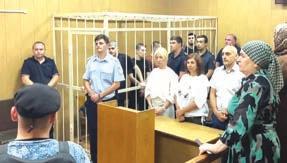
Last week, Russian courts sentenced 135 people to lengthy prison sentences in connection with a mass antisemitic riot in October 2023 at an airport in the predominantly Muslim Dagestan region.
Hundreds of rioters had stormed an airport in the city of Makhachkala, where a plane from Tel Aviv had just arrived. Israel’s war against Hamas had begun just a few weeks earlier.
Investigators said they completed probes into the participation of 139 rioters in the events.
Three additional people, whom they say had organized the riots via posts on a Telegram channel, were put on Russia’s wanted list.
The 135 convicted people were given prison terms ranging from six and a half to 15 years in prison for participating in mass riots and other crimes.
In January, four members of the mob were sentenced to a decade in a penal colony. In August, five rioters were sentenced to jail terms ranging from six to nine years.
Video footage at the time showed the protesters, mostly young men, waving Palestinian flags, breaking down glass doors, and running through the airport shouting “Allahu Akbar” (G-d is great).
More than 20 people were injured before security forces could contain the unrest. No passengers on the plane were hurt.
The Republic of Dagestan has seen notable amounts of antisemitism since the war between Israel and Hamas broke out. Last July, Jewish graves in the area were destroyed, though authorities said they were damaged in a traffic accident. Last June, 22 people were killed by Islamic State-linked terrorists in an attack that targeted two synagogues and two churches.
A fire in a shopping mall in Iraq took the lives of at least 69 people last week, with more than a dozen people still to be identified.
The blaze occurred in the Corniche Hypermarket mall in the town of Kut in Wasit province. The five-story building housed restaurants, shops and a supermarket. It had opened just days before the fire, which broke out on Wednesday on the second floor in an area selling perfume and cosmetics.

At least 45 people were rescued from the fire. Most of those who perished were on the upper floors
While the cause of the fire has not yet been determined, officials blamed lack of safety standards in the building for the scale of the tragedy. Provincial Gov. Mohammed al-Miyahi has said that the building owner did not implement fire safety measures and had not applied for required permits.
Poor building standards have often contributed to tragic fires in Iraq. In July 2021, a blaze at a hospital in the Iraqi city of Nasiriyah that killed between 60 to 92 people was determined to have been fueled by highly flammable, low-cost type of “sandwich panel” cladding that is illegal in Iraq.
In 2023, more than 100 people died in a fire at a wedding hall in the predominantly Christian area of Hamdaniya in Nineveh province after the ceiling panels above a pyrotechnic machine burst into flames.

TR US TE D
SINCE 1 99 8





tains continuous and consistent contact with the international organizations, and throughout the war, the IDF has facilitated the safe evacuations of their personnel from evacuated areas, in coordination with the troops and in accordance with operational requirements,” the statement continued.

On Monday, an IDF reservist soldier was killed during fighting in the southern Gaza Strip, the second death in one day as the army presses ahead with a new offensive in the area.
The hero who lost his life was Sgt. Maj. (res.) Vladimir Loza, 36, of the 5th Brigade’s 7020th Battalion, from Ashkelon.
Two other soldiers were injured in the incident.
According to a preliminary IDF probe, Loza was killed when a blast caused a building to collapse during operations in the Rafah area. The military suspects the blast was caused by an explosive device planted by Gazan fighters.
Earlier on Monday, Staff Sgt. Amit Cohen, 19, died fighting in Gaza. He had been in the Golani Brigade’s 13th Battalion. He died in an operational accident at a fortified position in Khan Younis, north of Rafah.
The explosion that killed him is believed to have been caused by improper handling of an explosive device. A fellow combat officer from the same battalion was seriously wounded in the blast.
Cohen hailed from Holon and left behind his parents and two younger siblings.
Loza’s death raised to 456 the toll of Israeli forces killed fighting inside Gaza since the war started with the devastating October 7, 2023, Hamas attack on southern Israel.
On Sunday, the IDF had issued an evacuation warning for several zones in Deir al-Balah, ahead of a new ground offensive in the area.
The military said that before operations began, it warned the civilian population to evacuate “and was in contact with the international organizations working in the area.”
“We emphasize that the IDF main-
The coordination efforts are to “facilitate the relocation of critical facilities to alternate locations based on the needs of the organizations,” the IDF said.

On Saturday, Brig. Gen. (res.) Giora Even Epstein, the Israeli Air Force’s most decorated fighter pilot and the world’s top supersonic jet ace, died at the age of 87.
Even Epstein was nicknamed the “Hawkeye,” and was credited with 17 aerial shoot downs – 16 Egyptian fighter jets and one Egyptian helicopter –making him a global aviation legend.
With an unmatched combat record, he served in the Israeli Air Force from 1961 until 1997 and later flew for El Al.
Even Epstein was born in 1938 in Kibbutz Negba in what was then called Palestine and developed a love for aviation from a young age as he watched Air Force planes fly above the southern community. When he was drafted into the Israel Defense Forces in 1956, he was initially rejected from the Air Force’s flight school for medical reasons and enlisted as a paratrooper.
After his mandatory service, he reapplied for flight school and was accepted, graduating with honors in 1963.
Four years later, during the Six Day War, Even Epstein scored his first kill while flying a French-made Dassault Mirage III, shooting down an Egyptian Sukhoi-7 fighter jet over the Sinai.
During the subsequent “War of Attrition” between Israel and Egypt, Even Epstein shot down another four Egyptian jets, earning him the honor of “flying ace,” a title given to pilots who have five or
confirmed aerial







When Israel’s neighbors attacked again in 1973, beginning the Yom Kippur War, Even Epstein downed another 12 Egyptian aircraft — one helicopter and 11 fighter jets — making him the “ace of aces,” the most successful fighter pilot of the supersonic jet era.
For his role in Israel’s victory, he was given the Medal of Distinguished Service, one of the country’s highest military honors.
After the war, he became commander of the IAF’s 117 Squadron and retired from regular service in 1977. Over the next several decades, Even Epstein served in the reserves, flying thousands of hours, including in the F-16, finally retiring in full in 1997, over 40 years after he was initially drafted. He then became a commercial pilot for El Al.
Two Israeli citizens have been charged with spying for Iran.
According to law enforcement, 33-year-old Tahani Abu Samhan, a teacher from the Bedouin village of Abu Queider in the Negev, had been in contact with an Iranian agent for a year. She allegedly filmed fighter jets taking off from the southern Nevatim airbase during the war with Iran at the behest of her handler, then passed the videos along to the agent.
Abu Samhan was paid in cash for being a spy.
Police said she was charged in the Beersheba District Court with the offenses of maintaining contact with a foreign agent and passing intelligence to the enemy.
In a separate statement, the Shin Bet and police announced that an IDF soldier was also charged with spying on behalf of Iran in return for financial compensation.
After being detained recently and following an investigation led by the Shin Bet, the police’s Lahav 433 major crimes unit and the Military Police, military prosecutors filed an indictment against the soldier on Thursday.
The joint statement said the soldier “knowingly maintained contact with Iranian elements and carried out tasks for them, including transferring footage of interceptions and filming rocket impact sites in Israel.”
The Shin Bet noted that the information the soldier provided to Iran was not classified and did not come to the soldier as part of his role in the IDF.
The agency added that the incident
was “especially grave” because the Israeli soldier “maintained contact with the enemy.” Military prosecutors charged the soldier with contacting a foreign agent and transmitting information to the enemy.
Over the past two years, Iran has ramped up its efforts to recruit Israelis as spies in exchange for money. In most cases, Israelis are recruited by Iranian handlers online and begin by carrying out small, innocuous tasks that gradually grow into more serious offenses, like intelligence gathering and even assassination plots.
According to the Israel Police, at least 47 suspects involved in 27 separate cases have been arrested since October 7, 2023. Charges have been filed against 40 of them, according to a security official.
On Sunday, all five members of a recently established ministerial committee voted to endorse the firing of Attorney General Gali Baharav-Miara. On July 27, the cabinet will hold an official vote on the issue.
Finance Minister Bezalel Smotrich, National Security Minister Itamar Ben Gvir, Science and Technology Minister Gila Gamliel, and Religious Services Minister Michael Malkieli are part of the committee, which is headed by Diaspora Affairs Minister Amichai Chikli. The committee, which was established in June after the government failed to oust Baharav-Miara using a 2000 cabinet resolution, has alleged that the attorney general has consistently blocked the government’s policies and appointments; enforced the law in criminal proceedings when it was in her best interest to do so; repeatedly abstained from representing the government in legal proceedings; regularly labeled government legislation unconstitutional; and sometimes denied the government the right to independent legal representation when she disagreed with it.

Baharav-Miara refused to appear before the committee’s two hearings regarding her firing, even though the panel requested her presence. She has maintained that her actions were lawful and necessary to prevent the government from breaking the law.
On Friday, the High Court of Justice ruled that the government’s potential decision to dismiss Baharav-Miara cannot be put into effect until the court rules on the move’s legality. However, on Sunday morning, the attorney general requested that the court also pause the firing process.
“The situation in which, for five weeks, the government has been advancing, step by step, a manifestly unlawful process for firing the attorney general is leading to ever-growing institutional damage to the Attorney General’s Office and the entire civil service,” she said. “Even if at the end the process and its results will be invalidated, the very fact of the advancement of an unlawful process — going as far as a debate in cabinet on the basis of a tainted decision — gives weight to arguments for the legitimacy of the process.”
However, Judge Noam Sohlberg, a week ago, said that the court would only get involved if the cabinet decides to fire the attorney general. Thus, it isn’t likely that Sohlberg will fulfill Baharav-Miara’s request to stop the government until then.

The ruling Likud party will hold an election on Wednesday to replace MK Yuli Edelstein, the Foreign Affairs and Defense Committee’s head.
Edelstein recently came under fire after he refused to push forward legislation to make charedi military exemptions law. Following Edelstein’s efforts to promote an alternate bill that would implement major draft quotas and punishments for draft dodgers, two charedi parties left Prime Minister Benjamin Netanyahu’s government last week in protest of Edelstein.
First, the United Torah Judaism party left the coalition last Monday because of
Edelstein’s proposed enlistment bill. Two days later, Shas exited the government, though the party stayed in the coalition.
On Monday afternoon, Ofir Katz, a Likud faction chairman, informed party MKs that elections to replace Edelstein would soon be held, and that nominations for a new committee head would be accepted until Tuesday at 8 p.m., after which the winner will be decided during a meeting on Wednesday. After the results are announced, the winner will have to be confirmed by the House Committee and Foreign Affairs and Defense Committee.
After Katz’s announcement, several lawmakers and ministers from Likud urged the prime minister to hold an “urgent” meeting in an effort to work on an outline for a law that would “ensure continued partnership with the ultra-Orthodox public and its representatives in the Knesset.” However, it is nearly impossible for a charedi enlistment law to be passed by the end of this week, which is when the current Knesset’s legislative session ends. On October 19, the Knesset will meet again.
Likud MK Hanoch Milwidsky said he would run for the position. On Sunday, Milwidsky called for the dismissal of Edelstein, whom he said acted in an “oppositional” way toward Netanyahu and the coalition. Last Thursday, Milwidsky said that, “as a Jew,” despite being secular, he is adamantly against “harming the world of Torah.”
“We need soldiers, yes, but no soldier will help if we break the thing that truly holds us up. And that thing is not some Western value that was born 200 years ago — it’s the Torah, it’s Judaism,” Milwidsky said.
Shortly before Edelstein’s dismissal was announced, Milwidsky and Amit Halevi, another Knesset member from Likud, forced a filibuster, blocking Edelstein from making progress on a military pension bill that was unrelated to the issue of drafting Charedim.
MK Eli Dalal said he too would compete for the position. MK Nissim Vaturi also announced his intention to run. Likud MK Tally Gotliv, on the other hand, endorsed MK Boaz Bismuth for the role.
Opposition leaders have slammed the move, which Yair Lapid of Yesh Atid called “illegitimate.”
“Let every mother of Israel know that Benjamin Netanyahu is selling her children, the security of all of us, the very idea of equality before the law, to the charedim,” Lapid said. “I hereby inform


































































the prime minister, if Yuli Edelstein is removed from the position of chairman of the Knesset Foreign Affairs and Defense Committee, the opposition members serving on the committee will resign.”
Blue and White-National Unity chairman Benny Gantz told reporters at a party meeting, “Israel’s security is being sacrificed on the altar of preserving the coalition — every Likud MK who votes in favor of ousting Edelstein should have the courage to look our fighters in the eyes first.”
Edelstein has insisted that a conscription law must include punishments for those who evade the draft. Charedi parties have said that any bill needs to include full amnesty for yeshiva students who have dodged the draft, despite being ordered to enlist. However, Edelstein’s proposed bill did not include amnesty. According to reports, the bill would obligate exempt students to use a fingerprint scanner every time they enter and exit their yeshivas.
The explosion happened early Friday morning at a sprawling sheriff’s department facility in East Los Angeles that is home to training programs and elite units such as the Special Enforcement Bureau, which conducts counterterrorism and rescue operations throughout the county and handles explosives.
Bomb squads handle potentially explosive materials almost daily in Los Angeles. Sheriff Robert Luna said the unit responds to roughly 1,100 calls per year, “dealing with some very dangerous situations or items.”
“So these aren’t people who don’t do this very often,” Sheriff Luna said. “They are fantastic experts.”
Joshua Kelley-Eklund, Victor Lemus and William Osborn are the deputies who lost their lives in the blast.
Detectives Kelley-Eklund, Lemus and Osborn had a combined 74 years of service in the department, and in the last few years, they had been assigned to the elite Special Enforcement Bureau’s arson and explosives arm.
ald Trump’s ”big, beautiful bill.”
“It is with a heavy heart that I announce my retirement from Congress. Recently, I was offered an opportunity in the private sector that was too exciting to pass up. As a result, today I notified the Speaker and the House of Representatives that I will resign from Congress as soon as the House votes once again on the reconciliation package,” Green said.
Green said that serving Tennessee’s 7th Congressional District was “the honor of a lifetime.”
“They asked me to deliver on the conservative values and principles we all hold dear, and I did my level best to do so. Along the way, we passed historic tax cuts, worked with President Trump to secure the border, and defended innocent life. I am extremely proud of my work as chairman of the Homeland Security Committee, and want to thank my staff, both in my 7th District office, as well as the professional staff on that committee,” Green said.
Three sheriff deputies who were members of the Los Angeles County Sheriff’s Department’s bomb squad were killed in an explosion on Friday at a training facility.
For now, investigators are unsure what caused the blast.
On Thursday, a day before the blast, residents of a condo in Santa Monica were notified that “an unidentified potential explosive device has been found in the garage” and that everyone needed to evacuate. The bomb squad had found what appeared to be explosive devices, which they brought back to their headquarters. The next day, members of the bomb squad were killed in an explosion at the same place where these devices were brought. Still, officials are not confirming that those devices ignited the blast.

Late Friday afternoon, hundreds of law enforcement officers in black-andblue cruisers and on motorcycles solemnly escorted three vans containing the bodies of the fallen deputies from the training facility to the medical examiner’s office. As residents gathered on the street waving American flags, other officers lining the route saluted the passing vans, standing as one in the stillness of the moment.

Sunday was Rep. Mark Green’s last day in office, leaving only 219 Republicans and 212 Democrats in the U.S. House of Representatives.
There are four vacancies in the House now, including those from late Democratic Reps. Sylvester Turner of Texas, Raul Grijalva of Arizona, and Gerry Connolly of Virginia.
The Republican congressman from Tennessee said last month that he would leave Congress for the private sector once the House voted again on President Don-
prisoned in El Salvador were returned home.
As part of the agreement, 48 Venezuelan political prisoners were also freed.
“Until today, more Americans were wrongfully held in Venezuela than any other country in the world,” Secretary of State Marco Rubio announced. “Every wrongfully detained American in Venezuela is now free and back in our homeland.”
A U.S. official named the freed Americans as Wilbert Joseph Castaneda, Jorge Marcelo Vargas, Lucas Hunter, Jonathan Pagan Gonzalez, Ronald Oribio Quintana, Erick Oribio Quintana, Fabian Buglione Reyes, Renzo Humanchumo Castillo, Juan Jose Faria Bricen, and Danud Hanid Ortiz.
The Venezuelan nationals arrived in their home country on Friday night. They were transported from El Salvador by air, according to Venezuelan President Nicolás Maduro.
He had said he would retire at another point but ended up staying on.
“Though I planned to retire at the end of the previous Congress, I stayed to ensure that President Trump’s border security measures and priorities make it through Congress,” he said. “By overseeing the border security portion of the reconciliation package, I have done that. After that, I will retire, and there will be a special election to replace me.”
Green had been in Congress since 2019. He is a veteran of the Army.
Green has endorsed Matt Van Epps to replace him in the U.S. House of Representatives, calling him a “true warrior.”
Green and Van Epps both served in the same Army special operations unit, which Green described as “a brotherhood that cannot be replicated anywhere else.”

On Friday, the Trump administration and Venezuela carried out a major prisoner swap. Venezuela freed 10 American prisoners. In exchange, 252 Venezuelan deportees whom the United States im-
Relying on the 1798 Alien Enemies Act, the Trump administration deported over 200 Venezuelan nationals to El Salvador. There, they were imprisoned in an infamous prison called the Terrorism Confinement Center (CECOT). The U.S. government has said that those deportees were members of the Tren de Aragua gang. Whether the Venezuelan government will now imprison those nationals is currently unknown.
A senior U.S. administration official said the exchange was “down to the wire.”
“We’re dealing with a regime in which, you know, there’s always a degree of uncertainty on their side, a degree of uncertainty from our side, and things that you would normally expect to move in a in a normal way tend to not move in a normal way,” the official said, noting that Venezuela took “one last stand in terms of delaying things” as a “power flex mechanism for them.”
“But at the end of the day, everything worked out, everything is fine, and everyone is safely on the way back to be reunited with their loved ones,” added the official.
On Friday afternoon, Venezuelan officials said a flight arrived from Texas carrying a number of Venezuelan nationals, including children whose parents were previously deported.
According to Nayib Bukele, the president of El Salvador, “all the Venezuelan nationals” held in his country have been freed. He published footage on social media of handcuffed individuals entering an airplane.











































During talks, Rubio worked closely with Bukele. The State Department’s Office of the Special Presidential Envoy for Hostage Affairs (SPEHA) also played a role in planning the transfer, according to a U.S. official.
On Friday, Adam Boehler, a hostage envoy for the U.S., held a meeting in El Salvador with Bukele and the freed U.S. nationals, whose health was confirmed. From there, the Americans were brought home.
Following the swap, President Donald Trump hailed Rubio as “a natural.”
“There’s never going to be anybody better than – the job you’re doing right now,” Trump said.
On Tuesday, the United States announced that it will once again pull out of the U.N.’s educational, scientific and cultural agency because it believes that its involvement is not in the country’s national interest. It also cited the agency’s anti-Israel stance. This decision comes only two years after the United States
rejoined UNESCO after leaving in 2018, during U.S. President Donald Trump’s first administration.
State Department spokesperson Tammy Bruce said the withdrawal was linked to UNESCO’s perceived agenda to “advance divisive social and cultural causes.”
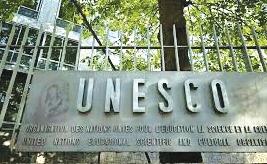
She added in a statement that UNESCO’s decision “to admit the ‘State of Palestine’ as a Member State is highly problematic, contrary to U.S. policy, and contributed to the proliferation of anti-Israel rhetoric within the organization.”
The decision will take effect at the end of December 2026.
This will be the third time that the United States has left UNESCO, which is based in Paris, and the second time during a Trump administration. It last rejoined the agency in 2023, under the Biden administration.



UNESCO’s Director General Audrey Azoulay said she “deeply” regrets the U.S. decision but said that it was expected and added that the agency “has prepared for it.” She also denied accusations of anti-Israel bias.
“These claims ... contradict the reality of UNESCO’s efforts, particularly in the field of Holocaust education and the fight against antisemitism,” she said.
The Trump administration in 2017 announced that the U.S. would withdraw from UNESCO, citing anti-Israel bias. That decision took effect a year later. The U.S. and Israel stopped financing UNESCO after it voted to include Palestine as a member state in 2011.
“The reasons put forward by the United States of America are the same as seven years ago, even though the situation has changed profoundly, political tensions have receded, and UNESCO today constitutes a rare forum for consensus on concrete and action-oriented multilateralism,” Azoulay added.

are necessary to keep sidewalks clear and prevent trash buildup.
The policy, up for final approval by San Francisco supervisors this week, targets at least 400 recreational vehicles in the city of 800,000 people.
Mayor Daniel Lurie and other supporters of the policy say motor homes are not suitable for long-term living and the city has a duty to both provide shelter to those in need and clean up the streets.
“We absolutely want to serve those families, those who are in crisis across San Francisco,” said Kunal Modi, who advises the mayor on health, homelessness and family services. “We feel the responsibility to help them get to a stable solution. And at the same time, we want to make sure that that stability is somewhere indoors and not exposed in the public roadway.”

The U.S. withdrawal is likely to affect UNESCO because the U.S. provides a notable share of the agency’s budget. Even so, UNESCO has diversified its funding sources in recent years, and the U.S. contribution has decreased, representing only 8% of the agency’s total budget.
Azoulay pledged that UNESCO will carry out its missions despite “inevitably reduced resources.” The agency is not considering any staff layoffs at this stage.
The United States previously pulled out of UNESCO under the Reagan administration in 1984 because it viewed the agency as mismanaged, corrupt and used to advance the interests of the Soviet Union. It rejoined in 2003 during George

Hundreds of people have been living on the streets of San Francisco in RVs, as they can’t afford proper housing. But the city is set to tackle these vehicles and clean up the streets. Now, it will adopt strict new parking limits the mayor says
Critics of the plan, however, say that it’s cruel to force people to give up their only home in exchange for a shot at traditional housing when there is not nearly enough units for all the people who need help; the mayor is only offering additional money to help 65 households.
San Francisco, like other U.S. cities, has seen an explosion in recent years of people living out of vehicles and RVs as the cost of living has risen.
The mayor’s proposal sets a two-hour parking limit citywide for all RVs and oversized vehicles longer than 22 feet or higher than 7 feet, regardless of whether they are being used as housing.
Under the accompanying permit program, RV residents registered with the city as of May are exempt from the parking limits. In exchange, they must accept the city’s offer of temporary or longer-term housing and get rid of their RV when it’s time to move. The city has budgeted more than half a million dollars to buy RVs from residents at $175 per foot. The permits will last for six months. People in RVs who arrive after May will not be eligible for the permit program and must abide by the two-hour rule.


On Monday, the Trump administration released a trove of records from the 1968 assassination of Rev. Martin Luther King Jr.
Over 240,000 pages of records were made available on the website of the U.S. National Archives and Records Administration. The Washington, D.C.-based agency says the release is in response to an executive order from Trump’s White House dating back to January.
King’s family was not happy with the release, saying the Federal Bureau of Investigation’s surveillance of the Black leader was tainted by the agency’s political bent at the time.
“We recognize that the release of documents concerning the assassination of our father, Dr. Martin Luther King Jr., has long been a subject of interest, captivating public curiosity for decades,” the family said in a statement. But “the release of these files must be viewed within their full historical context. During our father’s lifetime, he was relentlessly targeted by an invasive, predatory, and deeply disturbing disinformation and surveillance campaign orchestrated by J. Edgar Hoover through the Federal Bureau of Investigation.”
Hoover’s goal, the family says, was to find dirt on MLK in order to discredit him and the civil rights movement.
In January, Trump’s Executive Order 14176 ordered the release of materials in connection with the assassinations of King, President John F. Kennedy and presidential candidate Robert F. Kennedy. Files related to the JFK assassination were released in March.
Trump’s move to declassify the materials related to MLK also comes amid a political firestorm in Washington over the release of files related to Jeffrey Epstein, who died while awaiting trial in 2019.
Trump on the campaign trail promised to release records related to Epstein, and Attorney General Pam Bondi said earlier in the year that she had a supposed Epstein client list “sitting on my desk right now to review.”
“We need to be crystal clear on the fact that Trump releasing the MLK assassination files is not about transparency or justice,” said the Rev. Al Sharpton. “It’s a desperate attempt to distract people from the firestorm engulfing Trump over the Epstein files and the public unraveling of his credi-
bility among the MAGA base.”
Bernice King, the CEO of the Martin Luther King Jr. Center for Nonviolent Social Change, posted a picture on social media of her father with a nonplussed expression and a caption reading, “Now, do the Epstein files.”
MLK was killed on the balcony outside his motel room in Memphis, Tennessee, on April 4, 1968. James Earl Ray, a 40-year-old escaped fugitive, later confessed to the crime and was sentenced to a 99-year prison term. But Ray later tried to withdraw his confession and said he was set up by a man named Raoul. He maintained until his death in 1998 that he did not kill King.

Bye-bye corn syrup. Coca-Cola has announced that it will release a new version of Coke made with cane sugar, following a social media post from President Donald Trump last week in which he claimed he persuaded the company to replace high-fructose corn syrup.
The company said on Tuesday it will launch an “offering made with U.S. cane sugar” in the fall as part of its product range. Some versions of Coke already use cane sugar, including Coca-Cola sold in Mexico.
“This addition is designed to complement the company’s strong core portfolio and offer more choices across occasions and preferences,” Coca-Cola said in a statement.
CEO James Quincey said on a call with analysts that he thinks the drink “will be an enduring option for consumers” and noted that Coca-Cola uses cane sugar in several other of its beverages sold in the U.S., including lemonade and coffee.
Cane sugar is “blended into some of our other products, and so we are definitely looking to use the whole toolkit of available sweetening options where there are consumer preferenc-
es,” he said.
American-made Coca-Cola is made with high-fructose corn syrup, an ingredient that Trump’s Health and Human Services secretary, Robert F. Kennedy, Jr., has aggressively advocated against.
Kennedy, who has led the charge to remove many artificial and highly processed ingredients from American foods, has called high-fructose corn syrup a “formula for making you obese and diabetic” in a September episode of Dr. Jordan Peterson’s podcast. Corn syrup is a common and cheap sweetener, which is why Coca-Cola made the switch many years ago. Still, whether it’s made with sugar or corn syrup, sugar-filled soda isn’t heathy.
José Adolfo “Fito” Macías Villamar, the infamous leader of the Los Choneros gang, arrived in the United States on Sunday following his extradition from Ecuador. A day later, Macías appeared in federal court in Brooklyn, where he pleaded not guilty to seven counts of cocaine distribution and conspiracy and the illegal use and smuggling of firearms.
“Macías Villamar poses an extraordinary danger to the community,” wrote U.S. prosecutors. “The Court should enter a permanent order of detention, as no condition or combination of conditions can assure the safety of the community or assure Macías Villamar’s appearance at trial.”
The judge agreed to prosecutors’ request that Macías be held pending trial, given that he is a flight risk. Macías’s next court date has been set for September 19.
U.S. prosecutors allege that Macías, 45, in 2020, became the leader of the violent Los Choneros gang, which uses bribes, military-grade weapons such as machine guns and grenades, and hitmen who kill, torture, and abduct individuals in Ecuador. Additionally, the gang collaborates with Mexican drug cartels to ship cocaine and firearms to the U.S., according to prosecutors.
According to the U.S. attorney’s office, Los Choneros is “Ecuador’s most violent and powerful transnational criminal organization.”
He could be jailed for 20 years to life if he is found guilty. His attorney, Alexei Schacht, who has maintained that Macías is innocent, said he looks forward to seeing proof from the government of his client’s guilt. During Macías’s detainment, his health issues, including high blood pressure, gastritis, and bullet fragments in his body caused by a shooting years ago, must be managed properly, as per an order from Magistrate Judge Vera Scanlon. While serving a 34-year drug trafficking, organized crime, and murder sentence in Ecuador, Macías escaped from a jail in Guayaquil in January 2024, only two days before authorities planned to relocate him to a maximum-security prison. According to intelligence officials, Macías, informed beforehand of the relocation plans, escaped by walking out of the prison’s front door. He was recaptured 18 months later, on June 25, after Ecuadorian officials, with the U.S.’s assistance, found Macías in a custom-built hidden bunker beneath the villa of his friend, Verónica Narcisa Briones Zambrano. The indictment against him, which replaced a previous one unveiled in April, was filed on June 27 in the U.S. District Court for the Eastern District of New York. Previously, Macías escaped from prison in February 2013, though he was caught a few weeks later.
Macías remained in control of Los Choneros while in prison, “coordinating the trafficking of dangerous drugs and weapons,” according to U.S. prosecutors. He also had phones and internet access and maintained a presence on social media. In September 2023, Macías posted a music video recorded in his prison, taunting the Ecuadorian government.















the air conditioning.
But Natasha has been getting calls from people saying that they have found her cat, Torbo…only Natasha’s cat is Mauser and is not missing.
The mix-up comes from a website that has been selling t-shirts featuring a “missing cat” poster. The number on the fake ad on the shirt is Natasha’s.
“The use of a real number within the art created was not intentional,” a representative for the company said.
Still, “sometimes, like six times a day, I’m getting these really random phone calls and people leaving me voicemails saying that they found my cat and they want money for my cat,” Natasha said. “I’m like, ‘My cat’s at home in the air conditioning.’”
For now, the company has pulled the shirt from the website.
Despite the deluge of phone calls, Natasha doesn’t want to change her phone number.
“I’ve had my number for 20 years,” she said. “I don’t want to change it. I’ll just keep not answering.”
She added that she would like a “real apology” from the company.
“I feel like I deserve a t-shirt after this.”
That would be purr-fect.

Hold onto your planets. The largest piece of Mars ever found on Earth was sold for just over $5 million at an auction of rare geological and archaeological objects in New York on Wednesday.
The 54-pound rock named NWA 16788 was discovered in the Sahara Desert in Niger by a meteorite hunter in November 2023. Scientists believe that the rock had been blown off the surface of Mars by a massive asteroid strike and traveled 140 million miles to Earth.
The identity of the buyer of the meteorite was not immediately disclosed.
The final bid was $4.3 million. Adding various fees and costs, the official sale price was about $5.3 million, making it the most valuable meteorite ever sold at auction, Sotheby’s said.
At the same auction, a skeleton of a dinosaur, known as a Ceratosaurus nasicornis, came in at a whopping $26 million after six minutes of bidding.
The official sale price was $30.5 million with fees and costs. It was the third-highest amount paid for a dinosaur at auction. A Stegosaurus skeleton called “Apex” holds the record after it was sold for $44.6 million last year at Sotheby’s. The skeleton that was auctioned off last week is more than six feet tall and almost 11 feet long.
The red, brown and gray Mars meteorite that was sold last week is about 70% larger than the next largest piece of Mars found on Earth and represents nearly 7% of all the Martian material currently on this planet, Sotheby’s says. It measures nearly 15 inches by 11 inches by 6 inches.
There are only 400 Martian meteorites out of the more than 77,000 officially recognized meteorites found on Earth, the auction house said. Out of this world.


Indian police have arrested a man who was running a bogus embassy near the capital, New Dehli.
Harshvardhan Jain had rented space in a residential building and used cars with fake diplomatic plates to support his ruse.
The 47-year-old had impersonated an ambassador and allegedly duped people for money by promising overseas employment, according to senior police officer Sushil Ghule of Uttar Pradesh state’s special task force in northern India.
According to police, Jain claimed to have acted as an adviser or ambassador to entities such as “Seborga” or “Westarctica.”
Police recovered multiple doctored photographs showing Jain with world leaders and fake seals of India’s foreign ministry and nearly three dozen countries.
Jain was also suspected of illegal money laundering through shell companies abroad. He is also facing charges of forgery, impersonation and possessing fake documents.
Police recovered four cars bearing fake diplomatic plates and nearly 4.5 million Indian rupees ($52,095) and other foreign currencies in cash from Jain’s rented premises, which were adorned with international flags of several nations.
Welcome to the Republic of Make Believe.
One man’s trash is another man’s … troll?
Thomas Dambo and his team have been working for more than a decade turning wooden pallets, old furniture and wine barrels into statues that make a statement.
The Danish recycle artist and his team have created an army of 170 sculptures of trolls meant to show
humans how to live better without trashing the planet.
The edifices in his “Trail of a Thousand Trolls” project can be found in more than 20 countries and 21 U.S. states. Each year, Dambo and his team make about 25 new trolls, which stand up to 40 feet tall.
“I believe that we can make anything out of anything,” said Dambo. “We are drowning in trash. But we also know that one man’s trash is another man’s treasure.”
An installation of six sculptures called “Trolls Save the Humans” is on display at Filoli, a historic estate with 650 acres of forests and gardens in Woodside, California, about 30 miles south of San Francisco.
Dambo’s trolls each have their own personality and story. At Filoli, the troll Ibbi Pip builds birdhouses, Rosa Sunfinger plants flowers, and Kamma Can makes jewelry from people’s garbage.

“Each of them has a story to tell,” said Filoli CEO Kara Newport. “It inspires people to think of their own stories, what kind of creatures might live in their woods, and make that connection to living beings in nature.”
The trolls are supposedly there to teach humans how to live responsibly.
“They want to save the humans. So they do this by teaching them how to be better humans — be humans that don’t destroy nature,” said Dambo, 45, a poet and former hip-hop artist. “They hope to save them from being eaten by the older trolls.”
Dambo’s trolls are hidden in forests, mountains, jungles and grasslands throughout Europe and North America as well as countries such as Australia, Chile and South Korea.
“My exhibition now has four and a half million visitors a year globally, and it’s all made out of trash together with volunteers,” said Dambo. “That is such a huge proof of concept of why we should not throw things out, but why we should recycle it.”
From trash to troll… I feel like they’re just trolling us all.


This Wednesday evening, July 30, an event marking the first yahrtzeit of Mrs. Miriam Mintz a”h will take place at the DoubleTree by Hilton in Pikesville. The program, titled An Evening of Tribute, begins at 8:00 p.m. and is drawing significant attention from across the Baltimore Jewish community.
Miriam Mintz tragically passed away last summer at the age of 30. For ten years, she was a devoted educator in the Lamdeinu program at the Talmudical Academy of Baltimore. In this role, she taught and supported students with diverse learning needs, helping them succeed both academically and personally. Her consistency in the classroom and her deep commitment to each talmid made a lasting impression on generations of children and their families.
The event comes during the reflective days of the Three Weeks and the Nine Days, a time on the Jewish calendar when Klal Yisroel mourns the destruction of the Beis HaMikdash and reflects on the pain of galus. These weeks naturally lend themselves to introspection, and many seek opportunities for meaningful inspiration to strengthen their connection to Torah and avodah. This evening will offer just that — a moment of memory, chizuk, and purpose for our broader community.
In addition to honoring Miriam’s legacy, the event will serve as the launch of a new initiative inspired by the values she lived by. The project, which will be introduced for the first time on Wednesday night, aims to bring lasting benefit to the children of Baltimore in a way that reflects her vision and care.
9:30 am
Yoga with Deborah Bandos
11:00 am
Discussion Group with Rabbi KarpEichah- Why does she sit alone?
1:00 am
Arts & Crafts with Shifra
1:45 pm
Guitar with Yossi K
The program will feature a keynote address from Rabbi Shais Taub, along with divrei zikaron from Rabbi Yonason Seidemann, Rav of Kehilas B’nai Torah, and Rabbi Yechezkel Zweig, Menahel of Bais Yaakov High School. A video tribute will also be shown.
The event is open to men and women with separate seating. Advance RSVP is appreciated at www. MiriamsLegacy.org.
JULY
9:30 am
Yoga with Deborah Bandos
10:15 am
Anagrams with Malka Zweig
11:00 am
Discussion Group with Rabbi KarpKinos Throughout History I
1:00 am BINGO
1:45 pm
Guitar with Yossi K
JULY
9:30 am Yoga with Deborah Bandos
10:15 am
Anagrams with Malka Zweig 11:00 am
Discussion Group with Rabbi Karp- Kinos Throughout History II
1:00 am
Arts & Crafts with Shifra
1:45 pm
Guitar with Yossi K
2:00 pm
Chizuk Roundtable (women only)
THU 31
JULY
9:30 am
Yoga with Deborah Bandos
10:15 am
Anagrams with Malka Zweig
11:00 am
Discussion Group with Rabbi Karp- Stories from the Churban
1:00 am
Arts & Crafts with Shifra
2:00 pm
Music with Mr Fried
FRI 1
9:45 am
Yoga with Deborah Bandos
AUGUST 11:00 am
Discussion Group with Rabbi KarpFrom Shackles to Freedom
1:00 am
Music with Aharon Grayson

Amud HaYomi - encouraged by our Gedolei Yisrael - was established to enable a deeper comprehension of Shas. The Amud HaYomi initiative - which completed Masechta Brachos, Shabbos, and Eiruvin - is a 15-year blueprint which affords one an attainable path to know Shas. The program features over 200 live shiurim in North America, thousands of shiurim worldwide and a comprehensive website and app.



















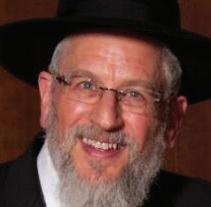
By Rabbi Zvi Teichman
The forty-two excursions the Children of Israel traveled during their sojourn in the desert, from the time they left Egypt until they set off on the final journey towards the promised land, is recorded for all of posterity.
We are taught that each one of these travels represent a unique challenge we overcame that forged our very character that eventually made us worthy of entering the holy land.
It is asserted in early sources that this record is a virtual map of what we would yet have to endure and conquer in all our journeys in the course of all our exiles, before we too would be deserving of the final redemption.
The Forty-Two Letter Name of G-d, embedded in the Prayer of Reb Nechunya ben HaKanah, Anna B’Choach, we are informed, corresponds to these forty-two travels, representing G-d accompanying us during those arduous times.
Strangely though if one were to count theses תועסמ — journeys, one would discover the Torah only reports how ועסיו — they journeyed, forty-one times!
Where is the missing trek?
The Vilna Gaon, the Gra, points out this deficiency and averses the following solution.
It is not written in the portion of Maasei but forty-one journeys, even though it is well known there were forty-two. It does record in its place how they encamped [in Shittim] but the actual reporting of the forty-second journey [from there] is written in the Book of Yehoshua, םיטשהמ ועסיו (א ג) — ‘and they journeyed from Shittim’, and [although] it does not report how ונחיו — they encamped there, nevertheless it states just םש וניליו — ‘that they stayed the night there prior to crossing [the Yarden]. (א וט והילא תרדא)
So, there were forty-two journeys in total after all, with forty-one of them reported in Massei, and the last trip in Yehoshua.
But what does the Gra mean when he states that it records ‘in its place’ how they encamped?
Indeed, when examining the verse, it makes reference to their encampment at that location twice.
They journeyed from the mountains of the passes and encamped in the plains of Moav by the Yarden at Yericho. (חמ גל רבדמב)
They encamped by the Yarden, from Bais Yeshimos until the plains of Shittim, in the plains of Moav.(טמ םש םש)
The Torah could have described the precise location with one verb. The extra mention, the Gra seems to be intimating, serves as compensation for the lack of ועסיו — and they journeyed.
What is the significance of this and why is it necessary since we have already discovered the missing ‘journey’?
Furthermore, why does he mention the fact that it never talks of their (ונחיו) encampment in Yehoshua and only refers to their (וניליו) last night on the bank of the Yarden river?
How is their one last night of lodging, before traversing the Yarden, relevant to the longer period of encampment they experienced in Shittim?
With Shittim being the last location, they would occupy before reaching their longed-for goal of entering the land, and in light of the tradition mentioned earlier that these journeys are portents for all future ones, then there must be something within this ‘journey’ that is instructive vis-a-vis ‘our’ last stand in Galus.
Shittim was the locale where the Jewish nation succumbed to the enticements of the daughters of Moav and Midyan. The Ohr HaChaim HaKadosh sees in the very name of this place of infamy the catalyst for their sin.
The root טוש is used elsewhere to indicate mindless roaming.
When man allows himself to follow his every whim and whimsy in determining his direction in life, he will find himself veering far from the tracks that lead to success. At times it is man’s instinct to relax that leads him off course. Often it is the distraction of current events that pique his curiosity in delving into matters he has no say or influence. At worst it stems from vying for position and stature, deluding oneself into all sorts of political maneuvering hoping to establish his position in the hierarchy of social standing and order.
We hopefully travel through life, honing our character as we conquer the challenges that seek to detour us from our purposeful aspirations. But there are lulls, when goals are not yet within our reach, and we must nevertheless remain mindful of who we are and what we represent, finding meaning and purpose in the quiet and modest moments of devotion, remaining consistent and committed even when our objectives are out of sight and intangible.
It is when we are encamped and withheld from opportunity, as so often our nation found itself frustrated during our long exile. To keep on ‘traveling’ even while we sit ‘still’ is the ultimate ‘journey’ we must perfect.
It takes a tremendous resolve to persevere and remain vibrant through quiet but persistent personal growth in Torah and Mitzvos, even when hoped for achievements elude us.
Perhaps this is the idea of ונחיו — encamped, being the replacement for ועסיו — to journey. We must discover new worlds within the realm of our own limited existence because the destinations reached in that journey are so much more thrilling and long lasting than the obvious ones.
If we cannot find that path, we will inevitably uncover other roads that will lead us astray.
Might that be the deeper message in the Gra’s noting that it never says ונחיו — they encamped, in Yehoshua, but rather וניליו — to stay the night?
One must live each day of one’s life as an opportunity of discovery, that has never existed before nor likely to return. There is no entrenching in place for a true servant of Hashem, merely a short respite each night so we may restore our strength with exciting new venues awaiting our discovery and conquering each day.
Several years ago I had the privilege to officiate at the levaya of one of Jewish Baltimore’s most colorful sons and Rabbis, the indefatigable Rabbi Moshe Shuvalsky, who served during his more than ninety years in many communities throughout the United States, leaving an indelible impact on all whom he encountered.
One grandson, Shmuli Dinovitz, conveyed a personal memory that sums up his greatness. In Shmuli’s own words.
One specific story keeps popping up in my head since last night. It seemed so insignificant at the time but now thirty years later I think this sums up my Zaidy.
My brother, Dovi and I were young boys — probably 5 or 6, and we went to spend Shabbos with our Bubby and Zaidy on Bancroft Rd.
On Friday night as we were walking towards Rabbi Taub’s Shul, a car pulled up beside us and started screaming anti-Semitic slurs at us, hurtling a glass bottle towards us, before zooming off.
Zaidy asked if we were ok, and boruch Hashem we were fine, but rattled.
We said, “But Zaidy, that man was screaming at us and even threw something at us!” Zaidy calmly but lovingly turned to us and said in true Zaidy fashion — “Yeah... and then what? Let’s go to Shul boys.”
Zaidy never let anything ever get to him or slow him down. I think this is a lesson we can all learn from. He was the humblest man who never ever would get distracted by trivialities, nonsense, nor caught up in machlokes. I do not think he would ever answer anyone back.
In the journey of life, we too often indulge in purposeless reactions, expending valuable time, much energy, and raw emotion, getting absolutely nowhere.
The next time you encounter a ‘roaming’ experience in life, implement the Shuvalsky method by honestly asking yourself: “Yeah... and then what?”
Boys (and girls), let us get on with real life, discovering new and thrilling encounters with Hashem, every moment of our lives!
You may reach the author at: Ravzt@ ohelmoshebaltimore.com
Matos discusses the laws of personal vows, war against Midian, and the request of Reuven and Gad.
Masei discusses the 42 journeys of the Jewish people, the borders of the Land, the cities of the Levites and cities of Refuge, as well as Tribal inheritance.
Life is not a vacation that we plan, it is a journey that G-d plans and we experience.

-Rabbi
Lord J. Sacks zt”l
The numerical value of יעסמ הלא is 216, the same exact value as the word הרובג , inner strength. You see, the willingness and inner strength to remain steadfast and strong in one's Judaism despite his journey, is of tantamount importance.

Words are extremely powerful. Words have the capacity to destroy and kill, or create and build. So much of what we are capable of achieving in life depends on the narrative we say to ourselves.
Parshas Matos/Masei begins with the discussion of vows and oaths, and the Torah teaches us ורבד לחי אל , one should not allow his words to become profane. Rashi says the word לחי is from the word ןילוח . Words are intended to be holy; to build, give life, and imbue strength. Words are not meant to be mundane, and taken lightly.
Here is a challenge, if you would like to join me. Ask yourself the following: The next time I open my mouth, let me think for an extra long second, is what I am about to say positive or negative?
Pesukim - 112/132
Words - 1,484/1,461
Letters - 5,652/5,773
Mitzvos - 2/6
The Nachal Kadumim sees a fascinating remez in the first letters of לארשי
, which spell:
These 4 letters stand for the 4 exiles: לבב ,ידמ
, and
Part of the journeying of the Jewish people includes our time we spend in exile.
The daughters of Tzelafchad were so righteous and wise that their case changed the laws of inheritance forever — they spoke up for their portion in the Land, and Hashem told Moshe, ֒תֹרְבֹּד
— the daughters of Tzelafchad speak rightly!” (Bamidbar 27:7).
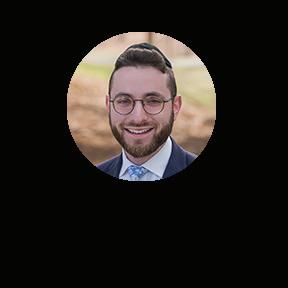
Rabbi Ori Strum is the author of “Ready. Set. Grow.” “Dove Tales,” and “Karpas: The Big Dipper.”
His shiurim and other Jewish content can be found on Torah Anytime and Meaningful Minute. He may be reached at 443-938-0822 or rabbistrumo@gmail.com

Is what I am about to say going to lift this person up or hurt them?

How we choose to answer these questions can literally be lifechanging!

Sometimes the tribes of the Jewish people are called “Shevatim” and sometimes they are called “Matos.”
Ironically, both words mean some type of stick or rod.
What is the difference between “Matos” and “Shevatim”? What is the connection between the 12 tribes and sticks?!



Zmanim are courtesy of MyZmanim and are for the 21209
Havdalah Zmanim are at 40 minutes past Shkiah.
Mercaz Torah U’Tefillah: EVERY 15 MINUTES
M-F: 6:15 AM, S-F: 6:30 AM, 6:45 AM, 7:00 AM, 7:15 AM, 7:30 AM, 7:45 AM, 8:00 AM, 8:15 AM, 8:30 AM, 8:45 AM, 9:00AM, 9:15AM, 9:30AM, 9:45AM, 10:00AM
Neitz Beit Yaakov [Sefaradi] M-F
Ohel Yakov S-F
6:00 AM Shomrei Emunah Congregation M-F
6:10 AM Agudath Israel of Baltimore M, Th
6:15 AM Kol Torah M, TH
Shearith Israel Congregation M, TH
6:20 AM Agudah of Greenspring M, TH
Agudath Israel of Baltimore S, T, W, F
Arugas HaBosem (Rabbi Taub's) S-F
Bnai Jacob Shaarei Zion Congregation M-F
Kehilath B'nai Torah M, TH
Pikesville Jewish CongregationM, TH
Shomrei Emunah Congregation S, M, TH
6:30 AM Agudah of Greenspring T, W, F
Chabad of Park Heights M-F
Darchei Tzedek M-F
Kehilath B'nai Torah T, W, F
Khal Bais Nosson M-F
Khal Ahavas Yisroel/ Tzemach Tzedek M-F
Kol Torah T, W, F
Ohr Yisroel M-F
Pikesville Jewish CongregationT, W, F
Shearith Israel Congregation T, W, F
Shomrei Emunah Congregation T, W, F
6:35 AM Aish Kodesh (downstairs Minyan) M, TH
Ohel Moshe M, TH
6:40 AM Aish Kodesh (downstairs Minyan) T, W, F
Bnai Jacob Shaarei Zion Congregation M, TH
6:45 AM B”H and Mesivta of Baltimore (Dirshu Minyan) S-F
Beth Abraham M, TH
Greenspring Sephardic Synagogue M-F
Ner Tamid M-F
Ohel Moshe T, W, F
Suburban Orthodox Congregation Toras Chaim M-F
The Adas: Chofetz Chaim Adas Bnei IsraelM, TH
6:50 AM Agudath Israel of Baltimore M, TH
Ahavat Shalom [Sefaradi] M, TH
Bais Medrash of Ranchleigh M, TH
Bnai Jacob Shaarei Zion Congregation T, W, F
Community Kollel Tiferes Moshe Aryeh M, TH Derech Chaim M-F
Kol Torah M-F
Ohel Moshe S
Ohr Hamizrach [Sefaradi] M, TH
Shomrei Emunah Congregation M, TH
The Shul at the Lubavitch Center M, TH
6:55 AM Beth Abraham T, W, F
Kol Torah M, TH
The Adas: Chofetz Chaim Adas Bnei IsraelT, W, F
7:00 AM Aish Kodesh (upstairs Minyan) M-F
Agudath Israel of Baltimore S, T, W, F
Ahavat Shalom [Sefaradi] T, W, F
Arugas HaBosem (Rabbi Taub's)S
Bais Medrash of Ranchleigh T, W, F
Community Kollel Tiferes Moshe Aryeh T, W, F Greenspring Sephardic Synagogue S
Khal Ahavas Yisroel/ Tzemach TzedekS
Kol Torah T, W, F
Moses Montefiore Anshe Emunah M-F
Ohr Hamizrach [Sefaradi] S, T, W, F
Shearith Israel Congregation S, M, TH
Shomrei Emunah Congregation T, W, F
Shomrei Mishmeres Hakodesh M-F
The Shul at the Lubavitch Center T, W, F Tiferes Yisroel M-F
7:05 AM Machzikei Torah (Sternhill's) M, TH
7:15 AM Kedushas Yisrael S Kol Torah S
Machzikei Torah (Sternhill's) S, T, W, F
Ner Israel Rabbinical College S-F
Shearith Israel Congregation T, W, F
edits, additions, or sponsorships, email ads@baltimorejewishhome.com
Shomrei Emunah CongregationS
Suburban Orthodox Congregation Toras Chaim S
The Adas: Chofetz Chaim Adas Bnei IsraelS
Tzeirei Anash M-F
7:20 AM Agudath Israel of Baltimore M, TH
Beth Tfiloh Congregation M-F
Kol Torah M-F
Ohr Hamizrach [Sefaradi] M, TH
Shomrei Emunah Congregation M, TH
7:30 AM Agudah of Greenspring S
Agudath Israel of Baltimore S, T, W, F
Ahavat Shalom [Sefaradi] S
Bais Haknesses Ohr HaChaim S-F
Bais Hamedrash and Mesivta of Baltimore S-F
Bais Medrash of Ranchleigh S
Beit Yaakov [Sefaradi] S
Bnai Jacob Shaarei Zion CongregationS
Chabad of Park Heights S
Community Kollel Tiferes Moshe Aryeh S-F
Darchei Tzedek S
Kedushas Yisrael S-F
Khal Bais Nosson S
Ner Israel Rabbinical College (Mechina) S-F
Ohr Hamizrach [Sefaradi] S, T, W, F
Shomrei Emunah Congregation T, W, F
7:45 AM Bnai Jacob Shaarei Zion Congregation M-F
Talmudical Academy S-F
Darchei Tzedek M-F
Mesivta Kesser Torah S-F
Mesivta Shaarei Chaim S-F
Yeshivas Torah Simcha (school days only) S-F
7:50 AM Derech Chaim S
Ner Tamid S
Ohel Moshe M-F
8:00 AM Agudath Israel of Baltimore S-F
Beth Abraham S
Chabad Israeli Center M-F
Darchei Tzedek S
Khal Ahavas Yisroel/ Tzemach TzedekS
Kehillas Meor HaTorah S
Ohr Yisroel S
Pikesville Jewish CongregationS
Shearith Israel Congregation S
Shomrei Emunah Congregation S-F
The Shul at the Lubavitch CenterS
Tiferes Yisroel S
Tzeirei Anash S
Yeshiva Tiferes Hatorah S-F
8:15 AM Kehilath B'nai Torah S
Kol Torah S
8:20 AM Bais Haknesses Ohr HaChaim S-F
8:25 AM Ohr Chadash Academy (School Days Only) S-F
8:30 AM Agudath Israel of Baltimore S-F
Chabad Israeli Center S
Machzikei Torah (Sternhill's) S-F
Ohel Moshe S
Ohr Hamizrach [Sefaradi] S
Shomrei Emunah Congregation S-F
Shomrei Mishmeres HakodeshS
9:00 AM Aish Kodesh S
Agudath Israel of Baltimore S-F
Bais Haknesses Ohr HaChaim S
Beth Tfiloh Congregation S
Bnai Jacob Shaarei Zion CongregationS
Moses Montefiore Anshe EmunahS
Shomrei Emunah Congregation S-F
Suburban Orthodox Congregation Toras Chaim S-F
Mincha Gedolah Mercaz Torah U’Tefillah
Khal Ahavas Yisroel/Tzemach Tzedek
1:45 PM Yeshivas Torah Simcha (school days only) M-Th
Reischer Minyan - 23 Walker Ave 2nd Floor
10055 Red Run Blvd Suite 295
2:15 PM Pikesville Beis Medrash - 15 Walker Ave
2:30 PM Bais Medrash of Ranchleigh
Community Kollel Tiferes Moshe Aryeh
Tov Pizza Mincha Minyan
Ner Israel Rabbinical College
Mesivta Shaarei Chaim (Community Kollel)
Shearith Israel Congregation
2:45 PM Kollel of Greenspring
Shearith Israel Congregation (S-Th)
3:00 PM Agudath Israel of Baltimore (S-F)
Bais Haknesses Ohr HaChaim
Mercaz Torah U'Tefillah
3:05 PM Kedushas Yisrael
3:15 PM Hat Box
3:22 PM Ohr Chadash Academy (School Days Only, Call to Confirm)
3:30 PM Mercaz Torah U’Tefillah
4:00 PM Agudath Israel of Baltimore (S-Th) Mercaz Torah U'Tefillah
4:30 PM Mercaz Torah U’Tefillah
5:00 PM Agudath Israel of Baltimore (S-F) Mercaz Torah U’Tefillah
5:30 PM Agudath Israel of Baltimore (S-Th) Mercaz Torah U’Tefillah
6:00 PM Agudath Israel of Baltimore (S-F) Mercaz Torah U’Tefillah
Shearith Israel Congregation (S-Th)
6:30 PM Agudath Israel of Baltimore (S-Th)
Mercaz Torah U’Tefillah
10 Min Before ShkiAh Chabad Israeli Center
14 Min Before ShkiAh Kol Torah
Ohel Yaakov
Shomrei Emunah Congregation
Plag
Suburban Orthodox Congregation Toras Chaim
Before Shkiah
Aish Kodesh
Agudath Israel of Baltimore
Agudah of Greenspring
Bais Haknesses Ohr HaChaim
Beth Abraham
Bnai Jacob Shaarei Zion Congregation
Darchei Tzedek
Kehillas Meor HaTorah
Kehilath B’nai Torah
Khal Ahavas Yisroel/ Tzemach Tzedek
Machzikei Torah (Sternhill’s)
Mercaz Torah U’Tefillah
Ner Tamid
Ohel Moshe
Ohr Hamizrach [Sefaradi]
Ohr Yisroel
Pikesville Jewish Congregation
Shearith Israel Congregation
Shomrei Emunah Congregation
Shomrei Mishmeres
Suburban Orthodox Congregation Toras Chaim
The Adas: Chofetz Chaim Adas Bnei Israel
The Shul at the Lubavitch Center
Tiferes Yisroel
Mercaz Torah U’Tefillah: EVERY 15 MINUTES 8:15
PM Agudath Israel of Baltimore
8:00
8:30 PM Agudath Israel of Baltimore
Maariv continued
9:00 PM Agudath Israel of Baltimore
Arugas Habosem
Shomrei Emunah Congregation
Suburban Orthodox Congregation Toras Chaim
9:20 PM Kol Torah
9:30 PM Agudah of Greenspring
Agudath Israel of Baltimore
Kedushas Yisrael
9:40 PM Ahavat Shalom [Sefaradi]
9:45 PM Bais Haknesses Ohr HaChaim
Kollel Erev Birchas Yitzchok (Luries)
Kollel of Greenspring
Machzikei Torah (Sternhill's)
Ohr Hamizrach [Sefaradi]
Yeshiva Tiferes Hatorah
9:50 PM Aish Kodesh
Community Kollel Tiferes Moshe Aryeh
Ohel Moshe
10:00 PM Agudath Israel of Baltimore
Darchei Tzedek
Kehilath B'nai Torah
Khal Ahavas Yisroel/ Tzemach Tzedek
Shearith Israel Congregation
Shomrei Emunah Congregation
10:05 PM Kol Torah
10:10 PM Ner Israel Rabbinical College
10:15 PM Derech Chaim
Khal Bais Nosson
10:30 PM Agudath Israel of Baltimore
11:00 PM Agudath Israel of Baltimore
11:30 PM Agudath Israel of Baltimore
Agudah of Greenspring - 6107 Greenspring Ave
Agudath Israel of Baltimore - 6200 Park Heights Ave
Ahavat Shalom - 3009 Northbrook Rd
Aish Kodesh - 6207 Ivymount Rd
Arugas HaBosem - 3509 Clarks Ln
Bais Dovid-Bais Medrash of Summit Park- 6800 Sylvale Ct
Bais Haknesses Ohr HaChaim - 3120 Clarks Ln
Bais Hamedrash and Mesivta of Baltimore - 6823 Old Pimlico Rd
Bais Medrash of Ranchleigh - 6618 Deancroft Rd
Beit Yaakov - 3615 Seven Mile Ln
Beth Abraham - 6208 Wallis Ave
Beth Tfiloh Congregation - 3300 Old Court Rd
Bnai Jacob Shaarei Zion Congregation - 6602 Park Heights Ave
Chabad Israeli Center - 7807 Seven Mile Ln
Chabad of Park Heights - 3402 Clarks Ln
Community Kollel Tiferes Moshe Aryeh - 3800 Labyrinth Rd
Darchei Tzedek - 3201 Seven Mile Ln
Derech Chaim - 6603 Pimlico Road
Greenspring Sephardic Synagogue 6611 Greenspring Ave.
Kedushas Yisrael - 6004 Park Heights Ave
Kehilath B’nai Torah - 6301 Green Meadow Pkwy
Kehillas Meor HaTorah - 6539 Pebble Brooke Rd
Khal Ahavas Yisroel/ Tzemach Tzedek - 6811 Park Heights Ave
Khal Bais Nosson - 2901 Taney Rd
Kol Torah - 2929 Fallstaff Rd
Kollel of Greenspring - 6504 Greenspring Ave.
Machzikei Torah - 6216 Biltmore Ave
Mercaz Torah U’Tefillah - 6500 Baythorne Rd
Mesivta Kesser Torah - 8400 Park Heights Ave
Mesivta Shaarei Chaim - 3800 Labyrinth Rd
Moses Montefiore Anshe Emunah - 7000 Rockland Hills Dr
Neuberger, Quinn, Gielen, Rubin & Gibber One South Street, 27th Floor
Ner Israel Rabbinical College - 400 Mt Wilson Ln
Ner Tamid - 6214 Pimlico Road
Ohel Moshe - 2808 Smith Ave
Ohel Yakov - 3200 Glen Ave
Ohr Chadash Academy - 7310 Park Heights Avenue
Ohr Hamizrach [Sefaradi] - 6813 Park Heights Ave
Ohr Yisroel - 2429 Lightfoot Dr
Pikesville Jewish Congregation - 7644 Carla Rd
Shearith Israel Congregation - 5835 Park Heights Ave
Shomrei Emunah Congregation - 6221 Greenspring Ave
Shomrei Mishmeres Hakodesh - 2821 W Strathmore Ave
Suburban Orthodox Congregation Toras Chaim - 7504 Seven Mile Ln
Talmudical Academy - 4445 Old Court Rd
1:50 PM Ohel Moshe
1 South Street, 27th Floor.
2:00
PM Agudath Israel of Baltimore (S-F)
Big Al @ The Knish Shop Party Room
Kol Torah
Market Maven
8:45 PM Darchei Tzedek
Ner Israel Rabbinical College (Mechina) Ohr Yisroel
8:50 PM Mesivta Shaarei Chaim (Etz Chaim Building)
8:55 PM Community Kollel Tiferes Moshe Aryeh
The Adas: Chofetz Chaim Adas Bnei Israel - 5915 Park Heights Ave
The Shul at the Lubavitch Center - 6701 Old Pimlico Rd
Tiferes Yisroel - 6201 Park Heights Ave
Tzeirei Anash - 6706 Cross County Blvd
Wealcatch Insurance - 37 Walker Ave 2nd floor
Yeshiva Tiferes Hatorah - 6819 Williamson Ave
Yeshivas Toras Simcha- 110 Sudbrook Ln.
THANK YOU TO OUR CORPORATE SPONSORS





































Chiel Anisfeld • Shuie Anisfeld • Ephraim Artman • Yehuda Bandari • Dovid Bierer • Bruce Blumenthal • Akiva Borck • Yechiel Cynamon • CJ Elefant • Eli Elefant • Yitzchok Elefant • Avi Fakheri • Bruce Fried • Akiva Gersten • Shraga Goldberg • Gavi Goldstein • Rami Goldstein • Gedalia Greengart • Yitzchok Dovid Greengart • Yonasan Grunhut • Howard Kaplon • Ezra A. Katz • Michoel Leib Katz • Yosef Meir Katz • Chuck Leve • Yudi Leve • Dovid Listhaus • Baruch Michelsohn • Yisroel Meir Michelsohn • Shloime Milworm • Yaakov Milworm • Jacob Molayem • Asher Morgenstern • Josh Morgenstern • David Moss • Yishai Mutterperl • Chaim Preiser • Erik Roskes • Dovid Steingroot • Mahti Topas • Asher Wealcatch • Calev Zirkind • Noam Zirkind • Ari Zuber • Yaakov Zuber • Benny Zweig • Yisroel Meyers • Akiva Yosef Sheffield • Ben Jessurun • Tzvi Goldfinger • Eliezer Zweig • Shalom Moskowitz • Aaron Dovid Cohen • Mordechai Cohen • Yisroel Bluman • Ori Boker Shokek • Leib Davids • Aryeh Dickstein
Reuven Feigenbaum
Kenny Friedman • Yitzy Goldberg • Chaim Greenspan • Michael Harris
Marc Katz
Chaim Kessler • Shua Kessler • Reuven Levinson • Zev Levy • Samuel Linzer • Dovid Mainstain • Zachary Mainstain • Benjamin Markowitz • Yehuda Milworm • Gil Neuman • Yitzchak Polsky • Yehudah Prero • Ben Ram • Nate Ram • Avi Rosensaft • Ari Rosner • Mark Rothstein • Bill Saks • Netanel Schwob • Zecharya Shear • Shmuel Sheffield • Howard Shiman • Yacov Tendler • Shimon Weichbrod • Aharon Yosef Wilson • Dovid Wilson • Benyamin Wise • Tzvi Wise • Jeremy Schnittman • Baruch Gutow • Moshe Gutow • Yossi Gutow • Aryeh Leib Freedman • Eli Abramson • Yosef Abramson • Modo Artman • Gary Bauman • Noson Berman • Baruch Bitman • Nachum Caplan • Shlomo Caplan • Dovid Cynamon • Tzvi Feigenbaum • Shmuel Fischler • Moshe Dovid Fischman • Colin fleisher • Larry Franks • Shlomo Freedman • Akiva Freund • Berel Galkin • Akiva Goldberg • Shuey Goldstein • Tzvi Golub • AJ Gordon • Eli Greengart • Ari Gross • Gershon Haft • Nechemya Jakobovits • Shaya Kohn • Judah Labovitz • Chaim Landau • Zalmy Lavi • Aviezri Lebowitz • Shaya Lerner • Zalmy Levin • Mordechai Leybovich • Shlomo Linzer • Bruce Mandel • Moshe Mayer • Zecharya Michelsohn • Doniel Moskowitz • Alan Newman • Justin Nicholas • Aryeh Nirenberg • Yosef Nissel • Zevy Pinter • Joshua Ribakow • Ezra Rosenberg • Ephey Rosenbloom • Ron Samet

• Yehoshua Sheffield • Yaakov Shotkin • Moshe Smith • Nachy Smith • Yehoshua Sopher • Aaron Spearman • Shuie Steinharter • Yitzchok Strauss • Neil Sweren • Yonoson Tesser • Tzvi Topper • Yonah Urszuy • James Vornov • Yaakov Wachtel • Binyomin Wealcatch • Shmuel Wealcatch • Peretz Wertenteil • Eliezer Zweig • Simcha Wolin • Eliezer Abramson • Yaakov Tikotzky • Ben Weiskind • Bill Goldberg • Mordechai Gottlieb • Shloime Grunhut • Yoni Herman • Pinchos Rabinowitz • Avie Rock • Sruly Lerner • Reven Feigenbaum • Shaina Wealcatch • Mindy Benyowitz • Eliana Leve • Avrohom Klugman • Ron Samet • Mordechai Gottlieb • Yehuda Prero • Shlomie Grunhut • Rochelle Goldberg • Bill Goldberg • Shana Gutow • Neil Sweren • Moshe Dovid Cohen • Francisco • Francisco Molas • Yitzy Goldberg • Shlomo Rosenbaum • Sheldon Caplan • Ephraim Dickstein • Tzvi Eisenberg • Shani Topper • Raisy Feigenbaum • Devora Chana Benyowitz • Binny Margolese • Ami Klein • Dovid Spatz • Vromie Mutterperl • Zachary Lewin • Chaya Yasnyi • Emuna Felps • Shira Safren • Tali Glickman • Tehilla Levin • Perri Klein • Sherri Sweren • Ori Topper • Dovi Turner • Izzy Hyatt • Chaya Sara Fruman • Sherri Zaslow • Shmuel Fischler • Avigayil Fischler • Elisha Kirschner • Yona Openden • Yaakov Cohen • Tzvi Feigenbaum
MODO ARTMAN, AKIVA GOLDBERG, SHUEY GOLDSTEIN, MORDECHAI GOTTLIEB, ZALMY LAVI, AND NEIL SWEREN
By Uri KaUfman

here is an old saying in Vaudeville: you don’t know your act until everything goes wrong. On October 7, 2023, the Israelis showed it is the same with a military plan. Israel spent over $1 billion building a high-tech fence around Gaza.
Upon its completion in December 2021, Defense Minister Benny Gantz hailed it at a ceremony, saying, “Our mission is to always stay one step ahead of the enemy.”
So Hamas terrorists blew holes in it, drove right through, and committed the worst massacre of Jews since the Holocaust.
An estimated 1,163 people were killed, thousands were wounded, and 251 were taken hostage. At least 347 of the dead were young people murdered at a nearby music festival. Some bodies were so charred that they could only be identified as human with a CT scan. Others were found with ash in their lungs, indicating that the victims had been burned alive.
One black mass was found to contain two human spines that had fused together, suggesting that the victims were hugging when fuel was poured on them and they were set on fire. An Israeli pathologist later said that “in normal times, murder is carried out very quickly, with a shooting or a stabbing…these were slow, cruel killings, burning people alive, shooting them in a row and then driving cars over them.”
The news of the butchery staggered Israel and, for a brief moment, even its critics. But things soon returned to normal. Or at least what passes for normal when it comes to the Jewish state.
No less than thirty-four different student organizations in Harvard signed a statement on October 10—before Israeli troops had even entered Gaza—saying that they “hold the Israeli regime entirely responsible for all unfolding violence.”
On October 23, Barack Obama wrote of Palestinians and Israelis that “nobody’s
hands are clean.” What terrible thing had the Israelis done to justify the moral equivalence? Obama said that the “occupation” had made the plight of the Palestinians “unbearable.” The trouble, of course, was that there was no occupation. Israel had withdrawn from Gaza almost twenty years before.
And then there was Amnesty International. In its press release on October 26, before Israel’s ground campaign in Gaza began, it called for “an immediate ceasefire by all parties in the occupied Gaza Strip.” Gaza was “occupied,” in Amnesty’s view, even though the only Israelis in it were the hostages.
It raises an obvious question, and that question is why. Why do so many otherwise serious people say so many things about Israel that are patently false?
In seeking an answer, one has only to spend a short time watching the chattering classes on television to see a pattern: the
more liberal a person’s political outlook, the more likely they are to attack Israel. It is an odd paradox. A visitor from another planet who studied political science and thumbed through an atlas would likely pause at the page dedicated to Israel. “This,” our alien friend would jot down, “must be a place admired by the humans known as ‘liberals.’”
So why the paradox? The best way to understand it is to engage in a thought experiment. Suppose that every fact related to the Hamas attack on October 7 occurred exactly as described: murders, beheadings, people burned alive, etc. But let’s change one fact. Let’s assume that the people who carried out the attack were not Palestinians. Let’s assume that they were Germans of another era, or Ukrainians of another era.
In other words, let’s assume that they were white people. Not people of color.
In this scenario, you wouldn’t expect the Biden Administration to give a multi-billion-dollar aid package to the white supremacist “innocent civilians.” But Biden approved billions in aid for Gaza, even as Hamas declared that it would rebuild and attack Israel again. The aid wasn’t even conditioned on the release of eight Americans being held hostage. Vice President Kamala Harris insisted that “we cannot conflate Hamas with the Palestinian people.”
And now let’s take this thought experiment all the way through by changing the identities of all the parties. In this parallel universe, white supremacists attack an African country on October 7, declaring that blacks are “apes and pigs.” Try to imagine a Republican president sending billions in aid to the white supremacist “innocent civilians,” or imagine the vice president arguing that we cannot conflate the white terrorists with the civilians who support them. It would never happen, and people would riot if it did. But those same people are eager to send billions to Palestinians in Gaza.
Here’s another thought experiment: imagine that Iran was run by white supremacists who cried that blacks were “apes and pigs” and that they were building a bomb to kill them all.
President Obama would sign an Iran deal with that country? Do you really think he would agree that it could continue its nuclear research, make missiles in eight years, enrich uranium in ten and come out of the pact completely in fifteen? Do you really think he would release over $100 billion to a white supremacist country, funding terrorism against black people?
In short, what we have is a classic example of cognitive dissonance. First identified by psychologist Leon Festinger in the 1950s, cognitive dissonance describes a well-known human phenomenon: when
international law, Israel is considered an occupying power in Gaza, even though it has removed its troops and settlers from the territory.”
International law? Which international law is that? The Times doesn’t say. But it repeated this bizarre legal conclusion on a regular basis. On June 1, 2016, for example—over ten years after the pullout was completed—readers were told that Gaza is “a society long under the shadow of a military occupation.” An August 19, 2022, story accused Israel of “restricting and silencing criticism of its 55-year military
Why do so many otherwise serious people say so many things about Israel that are patently false?
people are confronted with facts that contradict their beliefs, they usually change the facts, not the beliefs.
In the worldview of progressives, racism is endemic, and white people oppress people of color. It is through this lens that they see human history; it is this ancient wrong they wish to right. They, therefore, spring into action and fight for “social justice” the moment they see white people in conflict with people of color.
This argument admittedly had appeal decades ago in the days of Jim Crow or apartheid. But it has nothing to do with Israel and its conflict with the Palestinians. The differences are as obvious as they are numerous. But taking in these facts requires progressives to hold two conflicting thoughts in their heads at the same time: supporting Israel, despite a worldview that sees white people as oppressors. Better to change the facts than to confront the paradox—better, that is, to come down in support of people of color (i.e., the Palestinians). Overcoming cognitive dissonance is hard work.

Do you really think that
There are very few people willing to make the effort, even among those that should know better. After Ariel Sharon pulled out of Gaza in 2005, The New York Times and others went right on saying that Gaza was under Israeli military occupation, as if nothing had happened. Here is what the paper of record reported on September 20, 2007: “Under
own eyes?” The editors of The New York Times ask a similar question with each story. Perhaps the Geneva Convention has its international law, but the editors have their own. And that only tells half the story. The New York Times doesn’t just misstate the law. It also misstates the facts.
Long before the October 7 attack, the Times referred to Israel’s “blockade” of Gaza. In at least two articles by different reporters, it referred to it as a “draconian blockade.” In the words of the Times, the blockade “undermined the living conditions of more than two million Palestinians and led to a nearly 50 percent unemployment rate that is among the highest in the world.” Note that the “blockade” was the source of the suffering, not the refusal of Gazans to sign a peace treaty. The blame rested with Israel.
But why quibble over a minor detail like that? The whole story was false. Because the truth was, there was no blockade at all.
occupation of the West Bank and Gaza Strip.” I took these quotes from the news section. The op-eds and editorials in the Times are a whole other level of dysfunction and distortion. But at least they are opinions. This is the news deemed fit to print. And these were not silly oversights that slipped through while the managing editor was on vacation. They reflected all the reporting of Gaza. For the unspoken assumption of every story was that Israel owed a duty of care to Palestinians because Gaza was still under occupation.
A 2015 article described the plight of a Palestinian woman in Gaza who could not reach her betrothed in the West Bank because the heartless Israelis would not permit her to travel across their country. It is like criticizing the United States for not permitting people who lived in Nazi Germany or the Taliban Afghanistan to travel across America. In the midst of the Covid crisis, the Times ran a story criticizing Israel for not sharing vaccines with Gaza and thus “not protecting Palestinians under its occupation.” Yet another article decried the “struggle” that Gazan athletes faced in reaching competitions because of “travel restrictions” placed by the Israelis. Those words appeared right on the front page.
This is what I call Groucho Marx Journalism. Picture Groucho with the nose, the glasses, and the wiggling cigar saying, “Who are ya gonna believe: me or your
Yes, Israel placed restrictions on military materials such as steel and concrete, and even that got through, as evidenced by the hundreds of miles of tunnels that Hamas dug throughout Gaza. But for everything else—food, clothing, diapers, etc.—obtaining supply was, in the words of Israeli general Yom-Tov Samia, “as difficult as making a telephone call.”
The most recent full year for which there is data was 2022. In that year, Israel supplied Gaza with 5.7 billion gallons of water. Without it, Gaza would have died of thirst. Israel sent over 67,000 supply trucks filled with supplies. Without it, Gaza would have starved. Gazans needed a means to pay for all this. So the IDF gave licenses to 17,000 of them to work inside Israel. These steps were unprecedented in world history. How many North Koreans were earning a living in the U.S. during that conflict (or, for that matter, today)? How many trucks of supplies were sent into Islamic State?
In truth, Israel was, and is, the only country in the history of world supplying its enemies in time of war, purely on humanitarian grounds. But The New York Times flipped the script. In its telling, Gaza was still under occupation, even though the Israelis withdrew. In its telling, Israel enforced a “draconian blockade,” despite the unprecedented humanitarian supply. And who are ya gonna believe: me or your own eyes?
By Euan Ward
TACHAA, Lebanon — Hoda al-Ali searched for her son for 34 years, until the day she drew her final breath.
In 1986, when he was 18, he was arrested at a checkpoint by Syrian troops occupying Lebanon. A single mother of 10, al-Ali would scrape together what little she earned as a seamstress and travel every few months into neighboring Syria to scour its prisons. When her legs grew frail, her children took over, chasing the same breadcrumbs, never finding answers.
Then, in December, a video emerged.
President Bashar Assad of Syria had just been toppled by a lightning rebel offensive. In the chaos, a news crew filming outside a Syrian prison captured the image of an older man, disheveled and dazed, emerging from its gates. The family froze. They were sure it was the missing son, Ali, and their story quickly made headlines.
But days passed. Then weeks. Ali never returned. Hope faded. Lebanese officials offered no answers. Journalists stopped calling.
Months later, the search grinds on.
“We need to continue my mother’s mission,” said Ali’s brother Moammar, clutching an old photograph of him in the family’s home in northern Lebanon. “We still have hope he is alive.”
After the collapse of the Assad government, prison doors across the country flew open, and Syrians flooded in to search for traces of their friends and loved ones who had disappeared in untold numbers under the brutal regime. In Lebanon, however, many could only watch and wait.
Thousands of Lebanese had gone missing during Syria’s decades-long occupation of their country, which lasted from 1976 to 2005, and many were believed to
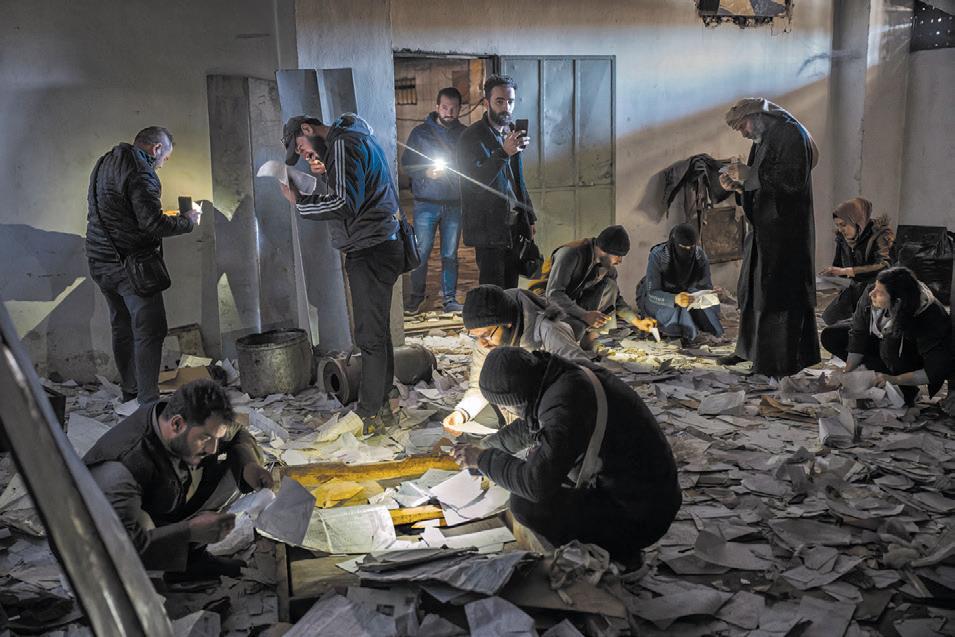
be imprisoned in Syria. For years, the tentacles of Assad’s security state extended well beyond Syria’s borders, ensnaring not only political opponents, but also ordinary civilians caught up in its machinery of suspicion. Dissidents, laborers, businesspeople — anyone could vanish.
The disappearances became a hallmark of Syria’s rule, sometimes aided by pro-Syrian Lebanese factions, with men and women taken from their homes or snatched off streets. Behind the checkpoints, Damascus’ secret police, known as the mukhabarat, ran detention sites across Lebanon — Beirut’s luxury Beau Rivage Hotel became shorthand for torture — and routinely transported suspects across the border to prisons like Sednaya.
When Assad was toppled, Lebanese officials estimated that more than 700 of their citizens were still imprisoned
in Syria, but some advocacy groups say there are far more unaccounted for. So far, only nine have returned, many after languishing in prison for decades.
Among them was Suheil Hamawi, who was taken from his home more than three decades ago.
Standing on his balcony overlooking the Mediterranean, Hamawi, 61, took a drag from his cigarette and gazed at the crystal clear waters below. It was a lot to take in: He had not seen the sea in 33 years.
“These scenes — you can only repeat them in your mind, and in your dreams,” Hamawi said. “I feel like I can breathe again.”
A member of a Lebanese Christian political party opposed to the Syrian occupation, Hamawi was abducted from his family home in 1992 by Syrian intelligence officers and taken across the border.
His capture was so abrupt that for the
first 17 years, his wife believed he had simply vanished. His son, Georges, was only 10 months old at the time. When Hamawi returned home, Georges was 33 and had a son of his own.
Hamawi spent the days and weeks after his release sipping cups of cardamom-infused coffee and video-calling relatives, many of their faces now unrecognizable to him.
“Do you remember my children?” said a cousin over the phone, sitting alongside her adult daughter.
“When I left her, she was so small,” Hamawi said in disbelief.
Former Lebanese prisoners interviewed by The New York Times described brutal treatment and torture, which they said was often more severe on account of their nationality.
Families of those missing said they had received no help from Lebanese authorities while Assad was in power, and had often been forced to spend thousands of dollars on bribes to Syrian security forces to get a sign of life from their relatives or win their release.
Bounced around the Assad regime’s network of prisons, Hamawi was first detained in Palestine Branch in Damascus and later in the notorious Sednaya. He spent the first five years in solitary confinement in a cell about 30 inches wide and 6 1/2 feet high. He described it as “a tomb with a door.”
“There was no light at all,” he said. “We used to recognize day from night by the sound of birds, or from the type of food they used to give us.”
In Sednaya, Hamawi grew close with his cellmates. They had been stripped of their names and given numbers — his was 55 — but that did not stop them from forging quiet bonds.
Most did not live to see the fall of the


Accelerated Degree Program
Earn
Torah-Focused Academics
The perfect bridge between seminary and the professional world
Personalized Advisement
Academic and career counseling to help support your goals
Professional Development
Preparing yourself for the world beyond the classroom
Strong Social Environment
A community fostering learning, growth & connection
Affordable Tuition
FAFSA eligible and scholarships available
















Assad regime, he said.
One Syrian friend, a journalist, disappeared after being told by guards that he had a visitor, only for Hamawi to find out 10 years later that he had been executed.
Another close friend, Fahed, a fellow Lebanese, refused treatment after becoming seriously ill, preferring to die than endure another day.
“He was stronger than me,” Hamawi said. “He accepted death, and I couldn’t.”
In recent months, Syria’s new rulers established a commission to investigate the fates of those who disappeared as part of a broader push for transitional justice.
In Lebanon, where Syria’s shadow still looms, families of the missing have been fighting a parallel battle for decades, pressing for accountability and answers.
But the Assad regime wielded outsize influence over Lebanon, refusing to shed light on the fate of the vanished, and Lebanese officials were often unable — or unwilling — to press the issue.
For Abir Abou Zeki, whose father was among the disappeared, it has been a lifelong fight.
It was June 12, 1987, when her father, Khalil, walked into her bedroom in a home just south of Beirut and planted a soft kiss
on her cheek for the last time.
The family of five was set to begin new lives in Germany. Their passports were ready. So were their plane tickets. But Khalil had to make one last business trip into Syria to collect spare truck parts for the company he worked for.
When days went by and he did not return in time for their flight, panic set in.
They eventually learned he had been arrested because he had a coffee tin containing American dollars, a criminal offense under the Assad regime.
Then he disappeared.
In the months that followed, their fam-
ily fell apart. Abou Zeki’s mother, Dalal, walked out, unable to cope with the stress of raising three children alone.
Their dreams of a new life had been shattered almost overnight.
For years, members of Lebanon’s Druze community, a close-knit religious

minority to which the family belongs, rallied around the family. Relatives and local officials made repeated appeals to Syrian authorities.
“The only answer was: ‘Yes, he is in our prisons. Consider him ours and don’t ask about him anymore,’” Abou Zeki said.
Years later, the message hardened: “Consider him dead,” she recalled.
When Assad was toppled in December, Abou Zeki, like so many others, allowed herself a flicker of hope — though it came tangled with guilt and fear.
“I think it’s selfish of me to say that I want him to be alive after all that torture,” she said. “But we suffered a lot. We used to feel guilty if we were eating or drinking — because he wasn’t able to. We felt warm while he was cold.”
“I think it’s easier to know that he died,” she said quietly.
Others are hoping wholeheartedly.
In the Ali family’s crumbling home in northern Lebanon, Moammar clutched the portrait of his brother Ali, taken when he was still a young man. As their mother once did, he was saving up for a trip across the border, hoping to find answers.
From the window, Syria was visible in the distance. Somewhere out there, they still believed, Ali is alive, waiting to be found.
“A mother’s feeling is never wrong,” Moammar said.
© The New York Times




(NOT ANYMORE)
By Mordechai Schmutter
Whew! Another exciting week at Camp S’dei Efron! As the first half of the summer winds to a close, it occurs to us that no one would notice that if we didn’t point it out. Here’s a summary of what we did this week, in case you think all we do in camp is get our knapsacks soaking wet, send home waivers, and loudly try to figure out, in unison, who we should appreciate.
1. Please make sure to apply sunscreen (sonscreen?) to your son every morning, unless you want him back a different color than you sent him. If all the kids are bright red, Color War is over before it begins.
2. All campers should wear their official camp T-shirts on trip days so we can identify them as part of our camp, because no offense, but 90% of your kids look the same from the back.
3. There’s a lost and found in the camp office, mostly made up of dirty socks. If you want to root through it, call us and we’ll be happy for you to come by. Maybe bring gloves.
4. Please make sure your sons do not bring any electronic devices to camp. This includes any kind of device where you turn it on and 120 kids lean over your shoulder. If we see a camper with one of these devices, we will have to confiscate it and call you to come pick it up from camp at the end of the day. Just look for the clot of 20 rebbeim leaning over each other’s shoulders.
This week we had hot dogs and ice cream, but not in that order. Also, the ice cream was pareve. And nut free. The hot dogs were nut free as well, but they were not pareve. Yuck Who even knows what’s in a pareve hot dog?
On Monday, we came out for “early dismissal” to find an ice cream truck waiting for us, right in front of the door! We all screamed, obviously. Even the ice cream guy. Also, we were still deaf from Color War.
Everyone got a choice of various types of ices, including snow cones, patriotic pops in honor of
the holiday (July 4th, not Shiva Assar B’Tammuz), and, as far as we can tell, crayon-flavored.
Then, on Wednesday, everyone was treated to a mini barbecue -- on mini grills, of course. The hot dogs were crayon-flavored as well.
Annual Carnival!
No, we did not do baking on Wednesday. That’s not why your kids came home covered in flour. And marshmallow fluff. We had a carnival, and there were a lot of great booths:
-“COKE OR PEPSI?” Which is it? We drank hundreds of cups and were up all night trying to figure it out.
-“FIND THE PENNY” – Hint: It was in the flour.
-“BOAT RACE” – Players had to race tiny boats across a pan of water by blowing on them with straws. The winner got tickets, and the loser got to keep the straws.
-“MOUSE RACE” – This was the highlight of the carnival. Four real live (at the time) mice were put into a maze, and contestants could bet on which one would reach the finish. This was not as illegal as it sounds. And actually, the mice had no real interest in racing. We’re not even sure they knew it was a carnival. Players could encourage their mice to finish the maze either verbally or by blowing on them. With straws from the boat race. B”H, none of the mice escaped and single-handedly shut down the camp.
At the end, everyone got to exchange their tickets for prizes from the prize store. There was a huge variety of fun prizes, including live (at the time) goldfish! We apologize to any parents who were not ready for that.
On Thursday, we headed over to the bowling alley for an exciting afternoon in an air-conditioned room. Also, there was bowling. But really, the main point was the air conditioning. And yes, apparently one is allowed to bowl when it’s not Chol Hamoed. Who knew?
We asked a shaylah.
We forgot to play sports this week. It happens. Oops. Our bad.
This Tuesday, Bunks Alef through Tes will be going to “Funbounce”. And with “fun” in the name, it has to be good. Legally. But they jump around all day anyway; they might as well do it in a padded room. And we just know that place is fun, because everyone is required to sign a waiver.
But seriously. Everyone is required to sign a waiver. Please fill it out and send it back by Monday, or your son will have to stay home, where he will proceed to bounce off the walls anyway. So you might as well.
This Wednesday, Bunks Lamed Vav and Kuf Yud Tes will be going on an overnight. We have a lot of fun activities planned, such as another BBQ, a night swim (which is not as dangerous as it sounds), and a rafting trip down the Potomac!
We will be sleeping in a shul, just like they did in old Europe right before THEY went rafting down the Potomac (but after their BBQ).
With the first half of the summer coming to an end, Baruch Hashem, we’d like to acknowledge the hard work of all of the counselors, junior counselors, rebbeim, and junior rebbeim, who spent all day out in the heat pitching balls in slow motion, herding the kids on and off buses, confiscating electronic devices, and trying to teach kids that there are actually parshios during the summer despite the fact that there’s no school. We can’t put a price on the things that they do for us. But we can make suggestions.
NOTE: From previous experience, we suggest that you do not give the money directly to your children, as envelopes have gotten “lost” in the past, and kids have attempted to buy out the entire canteen. We need to save something for the second half.
Mordechai Schmutter is a freelance writer and a humor columnist for Hamodia and other magazines. He has also published eight books and does stand-up comedy. You can contact him at MSchmutter@gmail.com.
Elementary School
For the 2025-2026 School Year
Upper & Lower Elementary Assistant Positions P/T and/or F/T
O ce Staff Member with strong computer and communication skills
Middle School
For the 2025-2026 School Year
Pre Algebra Teacher (3 periods)
Gold Class Assistant (4 periods)
History Teacher (3 periods)
English Teacher (2 periods)
High School
For the 2025-2026 School Year
M-Th 2:50-3:35pm, English 10th Grade
M-Th 3:38-4:23pm, US History 9th Grade
M-Th 4:33-5:17pm, English 10th Grade
M-Th 5:20-6:05pm, English 9th Grade
M-Th 4:33-6:05pm, AP Calculus

As told to Rebbetzin Sara Gross
Okay, I admit it—I’m a news addict. I love to check the news multiple times a day and keep updated on local and Israeli news. I bounce from site to site and check for any updates several times a day.
Recently, I went to an inspiring speech about the power of making small commitments in technology control and how a little change goes a long way. Feeling inspired to put my inspiration into action, I thought honestly about what I was willing to commit to and stick to. The big stuff ran through my mind, and I immediately felt overwhelmed by those options.
I decided that when I would search the Jewish sites for news, I would stop there. Usually, I would
end up checking foxnews.com, and I would try to avoid doing that. Immediately, I felt a little silly. My kabbalah was so small that it almost felt embarrassing after an inspired high. Then I decided to stick to it.
I was shocked. This tiny commitment made me feel more in control of where I looked and what I clicked on. Because I made this small choice, my ability to choose—and not just be sucked into whatever I was looking at—grew stronger. I never expected that a little change would be so big.
Who you text — and who can text you — is finally up to you. “Text-less” is a texting control app for select basic phones that lets you manage mes-
saging with precision. You can allow texting only with approved contacts (whitelisting), decide who can send you multimedia messages (pictures, audio, group messages), or even set the phone to receive texts without being able to send. This is especially useful for receiving verification codes or urgent updates — and is also perfect for parents who want to be able to text their children without giving them open access to texting.
The app also has the option for automatic replies — so if someone sends a message, the phone can respond with: “This phone doesn’t receive texts. Please call instead,” or “This phone does not receive MMS messages.”
These features are available only on certain basic phones, and the






settings are protected by a secure password to prevent tampering. Textless is ideal for anyone who needs limited texting access — but wants to keep it fully on their terms.





Daniel Hefter (Baltimore) & Orly Olbum (Pittsburgh)
Avrami Saltzman (Milwaukee) & Chava Rina Benyowitz (Baltimore)
Baruch Nosenchuk & Leah Skaist
Chana Robinson & Shimon Dorfman (Silver Spring)
Shimshon Klein (Baltimore) & Sarit Schwartz (Jackson)
Want to see your simcha here? Email mazeltov@baltimorejewishhome.com or text 443-675-6507 to submit your simcha!

Join Our Team
Open Positions:
Preschool/Elementary School:
Kodesh and General Studies Assistants
Permanent Subs
Office Secretary
Middle School:
Ivrit Teacher
General Studies Teachers
AM & PM Tutors
Permanent Sub
High School:
Office Support: Part time, PM
General Studies Teachers
Computer Assistants
AM & PM Tutors
IT: Tier II IT Support Technician
Early Learning Center: Teachers
Assistants
Office Manager
Development Office Assistant


For more information please visit:
https://www.baisyaakov.net/employment/



By Bassy Schwartz, LMFT
e’re all chasing happiness. We want it for ourselves, our kids, our marriages, our homes. We want a life that feels good: peaceful, joyful, settled. We try to create that feeling with a full Shabbos table, coordinated family pictures, bedtime routines, couple’s getaways, and wholesome Yomim Tovim. But here’s the thing: a lot of us don’t actually know what we’re chasing anymore.
Somewhere along the way, “happy” got tangled up with “no one’s crying,” “no one’s slamming doors,” or “we all get along enough of the time.” We’ve confused emotional health with emotional ease. But they’re not the same.
Being emotionally healthy doesn’t mean your home is always calm. It doesn’t mean your kids never melt down or that you never lose your cool. It doesn’t mean you’re happy all the time .In fact, being emotionally healthy often means you’re sitting with uncomfortable feelings – your own and everyone else’s. It means you’re learning to stay present through the hard stuff, not just the highlight reel.
According to the actual science, happiness (the real, sustainable kind) comes down to two main things:
1. The ability to self-regulate across many different situations.
2. The ability to repair after rupture. In other words, it’s not about how often you feel good. It’s about how you handle it when you don’t. Can you stay steady(ish) when your kid is unraveling? Can you come back and make things right after you snapped at your spouse or brushed off your child?
Happiness isn’t about avoiding stress. It’s about how we relate to ourselves and each other in the stress. That’s the gold. So in that spirit, here’s what I wish you knew about emotional healthy families:
1. I wish you knew that emotional health isn’t always visible from the outside.
The family that looks flawless at the simcha you’re at, the one with the polished kids, matching bows, and cooperative Shabbos zemiros, might be quietly unrav-

eling inside. And the family that’s a little noisy, a little late, with wrinkled shirts and kids who refuse to wear tights? They might be the emotionally richest house on the block – connected, forgiving, and full of life. Don’t let the presentation fool you. Emotional health doesn’t always match the aesthetics.
who you think it is.
Sometimes it’s the loud kid who gets all the attention – the tantrums, the drama, the talking-back. But often, that kid is just expressing what the rest of the family is holding in. They’re the messenger. The truth-teller. The one whose behavior reflects the stress, tension, or
It means you’re learning to stay present through the hard stuff, not just the highlight reel.
2. I wish you knew that it’s not about getting it right. It’s about coming back when it goes wrong.
Every parent loses it sometimes. Every kid says something wild in the heat of the moment. Every marriage has its mess. That’s not the problem. The question is: can you repair? Can you come back and say, “That didn’t go the way I wanted. Let’s try again”? Can you let your child, or your spouse, or yourself be human AND take responsibility for a misstep, in the same instance? That’s emotional health.
3. I wish you knew that the “problem” in the family isn’t always
disconnection that no one else knows how to say out loud. Sometimes the child who “needs help” is actually carrying the emotional weight for the whole system. Be curious before you label.
4. I wish you knew that connection is the medicine.
Not lectures. Not punishments. Not sticker charts, consequences, or perfectly color-coded routines. Those things have their place, sure – but they’re just tools. The real change happens when your child feels seen, known, and safe, even when they mess up. That’s what creates emotional resilience. That’s what calms the storm – not
because the storm is bad, but because they know they’re not alone in it.
5. I wish you knew that adversity teaches us more about ourselves than it does about the other person.
The fights, the conflict, the drama – it’s not just about what’s wrong with them. It’s often a flashlight on the parts of us we’ve neglected. Our boundaries, our voice, our needs, our wounds. Sometimes the thing you’re reacting to in someone else is actually the thing you’ve been avoiding attending to in yourself.
6. I wish you knew that treating symptoms is a hamster wheel.
A child won’t stop yelling? A spouse goes cold when things get hard? A teen keeps shutting down? Physical, financial, practical obstacles on a consistent basis? Yes, it’s tempting to try and fix the behavior. But symptoms are just signals. Notifications. Messages that something underneath needs attention. If we stay focused only on the surface: “better behavior,” “less discomfort” or “minimal fighting,” we miss the chance to understand the deeper story. And that story is where real healing lives.
Emotional health isn’t always happy. That the goal isn’t perfection – it’s presence. That your worth as a parent, a partner, a person doesn’t come from how smooth things look on the outside. It comes from your willingness to stay in the process, to keep showing up, and to repair when things fall apart. Healing is possible. Change is slow, but powerful. And there’s no such thing as a perfect family – just families who are willing to grow.
Bassy Schwartz, a licensed Marriage and Family Therapist, is trained in Emotionally Focused Therapy. She brings a compassionate and unique approach to her practice, focusing on couples and individuals dealing with conflict and disconnect due to childhood emotional neglect and complex family dynamics. Bassy empowers clients to overcome relationship challenges, rediscover their strengths, and build deeper, more meaningful relationships.















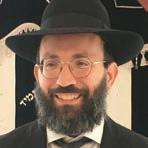
ABy Rabbi Shraga Freedman
few years ago, Yisrael Schwartz was flying back to Baltimore from Miami and in a rush to deplane, he forgot his tallis and tefillin in the overhead compartment.
Hours later he scoured every counter and office—Southwest’s baggage area, Lost and Found, the ticket desk—but no one had seen it. It seemed hopeless.
That night, desperate and dejected,
was late, helping with baggage. Somehow, Joe would often know in advance when Yisrael had a flight and would text him early that morning: “You flying today? You gonna make it?” He seemed to anticipate everything. Yisrael appreciated Joe deeply and expressed his gratitude often.
Though it felt like a long shot, Yisrael texted Joe that night about his lost tallis bag. The next morning, Yisrael woke up to a jolt—a picture message from Joe. It
detailing how Joe Franklin had embodied everything good about the airline. He wrote how Joe had made him feel like a VIP every time he flew—always ready with a boarding pass, a smile, and a sense that someone was truly looking out for him. Yisrael described the tefillin story in full and ended the letter with a plea: “This man is Southwest. Please recognize him.”
About six weeks later, Yisrael’s phone lit up. Joe was sending him messages.
Unbeknownst to Yisrael, his letter had been read aloud at Southwest Airlines’ nationwide quarterly meeting, with tens of thousands of employees listening in. The CEO personally mentioned Joe Franklin by name and shared the tefillin story. Joe was honored as Southwest Employee of the Month. Balloons, a trophy, and fanfare followed. Joe was elated—and deeply touched.
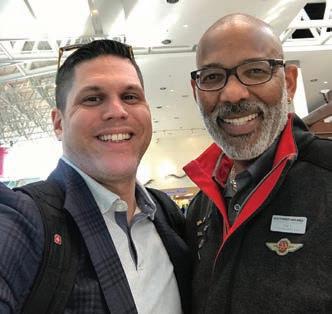


Since then, the deep mutual respect between Yisrael and Joe has only grown. To this day, Joe introduces Yisrael to other Southwest staff and makes sure he’s always taken care of.
The two men—an Orthodox Jew and a kindhearted airline worker—became living proof of mutual respect, compassion, and the power of Kiddush Hashem.
Author’s Note: The Iron Dome story in this column could not be verified and parts of it may not be accurate. We apologize for the oversight.
Rabbi Shraga Freedman is the author of Sefer Mekadshei Shemecha, Living Kiddush Hashem, and A Life Worth Living.
Email LivingKiddushHashem@ gmail.com for a free sefer. Visit LivingKiddushHashem.org for more







Your bike costs more than your car.

You spend at least an hour a day watching GoPro footage.

You know where every single pothole is within a 5-mile radius of your home.

Your bike is cleaner than your house.

Your bike has a nickname, and you’re not at all embarrassed.

When driving, you yell, “On your right!” when you pass another car.

After every weekend, your phone is filled with photos of mountains, trails, descents, signposts, fields, sunsets…


You hear someone had a crash and your first question is “How’s the bike?”


You start yelling at cars to “hold your line.”
You have more money invested in your biking clothes than in the rest of your combined wardrobe.



You have more bike jerseys than dress shirts.
A Power Bar tastes better than a Snickers.
You can’t seem to get to work by 8:30 AM, even for important meetings, but you don’t have any problems at all meeting your buddies at 5:00 AM for a ride.

You can tell your spouse, with a straight face, that it’s too hot to mow the lawn and then bike off for a century.

You tailgate a semi-trailer to get the drafting effect.

You schedule family simchos around your biking schedule (which is why your kid’s bris was at 11 AM).
Two bikes are traveling toward each other at a constant speed of 10 mph. When the bikes are 20 miles apart, a fly flies from the front wheel of one of the bikes toward the other bike at a constant speed of 25 mph. As soon as it reaches the front wheel of the other bike, it immediately turns around and flies at 25 mph toward the first bike. It continues this pattern until the two bikes smush the fly between the two front tires.
How far did the fly travel?

Therefore, the fly is flying back and forth at 25 mph for 1 hour.
to touch, given that they start 20 miles apart and are each traveling toward each other at 10 mph.
Answer: 25 miles. The simplest approach is to consider the time involved. The bikes will take 1 hour

1. How many miles is the 2025 Tour de France?
a. 1,575
b. 2,074
c. 3,267
d. 5,344
2. Maurice Garin won the very first Tour de France in 1903. The next year, he won the Tour’s second running but was eventually stripped of his victory for cheating. How did he cheat?
a. He took a train to the finish line
b. He used performance enhancing drugs
c. He knocked his main opponent off of his bike, resulting in a calf injury which prevented him from completing the race
d. He had his team members throw out all water at pit stops after he drank, so that his opponents would go thirsty
3. Over the course of the Tour de

France, approximately how many calories does the average biker burn?
a. 33,000
b. 73,000
c. 111,000
d. 127,000
4. What was Lance Armstrong’s average speed in the 1999 Tour de France?
a. 19 MPH
b. 25 MPH
c. 32 MPH
d. 37 MPH
e. 45 MPH
5. Who is awarded the yellow jacket?
a. The winner of the day
b. The best climber
c. The overall leader of the race
d. The last place driver of the day
6. The green jersey is awarded to the racer who is best at doing what?

a. Climbing
b. Sprinting
c. Assisting his teammates
d. Knocking out an opponent
Answers:
1-B
2-A
3-D (That is the equivalent of eating a total of 672 jelly doughnuts… which is exactly what I would do if I burned that many calories)
4-B
5-C
6-B
Scorecard
5-6 correct: You get the Yellow Jacket!
3-4 correct: You may not be in Tour de France yet, but good luck on Bike 4 Chai.
0-2 correct: You need to start cheating a little bit my friend…Live Strong!
A pedestrian stepped off the curb and into the road without looking one day and promptly got knocked flat by a passing cyclist.
“You were really lucky there,” said the cyclist.
“What on earth are you talking about?! That really hurt!” said the pedestrian, still on the pavement, rubbing his head.

“Well, usually I drive a bus!” the cyclist replied.

How do you think your hotel gets cleaned? How do you think you get food on your [expletive] table? Who do you think washes your dishes?
– Hunter Biden in a recent podcast
Because I’ll tell you what, if I became president… I would pick up the phone and call the [expletive] president of El Salvador and say, “You either [expletive] send illegal immigrants imprisoned in CECOT penitentiary back or I’m going to [expletive] invade.” -ibid.
I don’t really care what the former First Drug Addict thinks.
– Border Czar Tom Homan
I just thank G-d every morning when I wake up that we have President Trump in the Oval Office. And, because of President Trump, in seven weeks we have the most secure border in our nation’s history. -ibid.
If the comedians are being attacked, then that means our Constitution is being dismantled. What are we going to do as a country? We must protect our Constitution and we must protect our democracy. This is bigger than just the cancellation of a television show.
- The View’s Sunny Hostin, after it was announced that Stephen Colbert’s late night show will end in May 2026
I decided to keep wearing a kippah. A few days after I started wearing it, I was the speaker pro tem, and when I was up in the speaker’s chair, sitting up there in the gallery were the public watches, an Orthodox family came. And I knew they were Orthodox. The kids were wearing the tzitzit; they were like eight, nine, ten. They like exploded with excitement to the point that security went to talk to them. They were talking to their parents and everything else, all excited… I thought at that moment, you know, the Big Man Upstairs is probably sending me a sign that I ought to keep it on.
- Congressman Randy Fine (R-FL) at the Agudath’s Federal Affairs Congressional Reception explaining why he started wearing a yarmulka full-time
The cool thing, though, is that now people send them to me.
- ibid.
Every Shabbos, we put our phones away. We have a family meal, talk about the Torah and no politics.
- Prime Minister Netanyahu in a recent interview
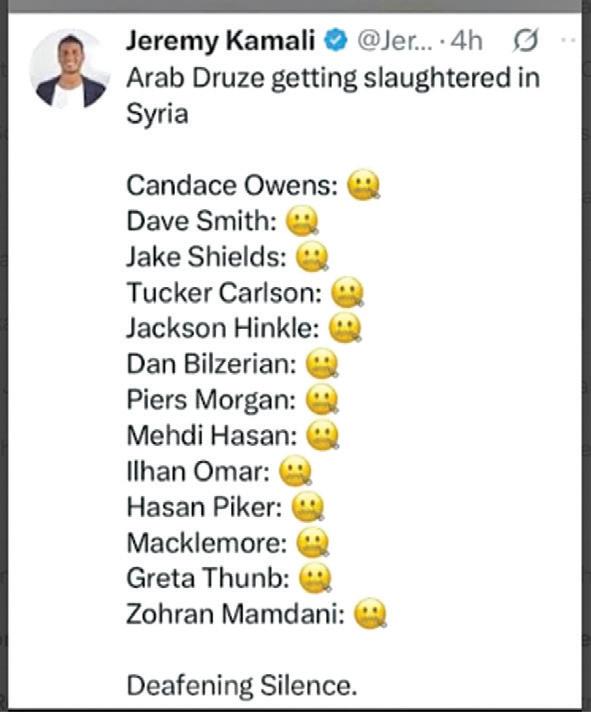
At this point, no.
- Billy Joel when asked by Bill Maher if he cares what woke people think of him
The first six months of Donald Trump’s second presidency have been the most “successful” of any American president since Franklin D. Roosevelt, according to an analysis conducted by Newsweek using AI.
- Newsweek
I’ve met James Comey. I’ve met John Brennan. And I’ll be honest with you – I don’t think either of them could follow more than six of the Ten Commandments on a good day.
– Sen. John Kennedy (R-LA)
These fellas are about as popular as male pattern baldness—and about as useful, too.
- ibid.
Disgusting! 25 nations put pressure on Israel instead of savages of Hamas! Gaza suffers for one reason: Hamas rejects EVERY proposal. Blaming Israel is irrational.
– U.S. Ambassador to Israel Mike Huckabee responding to a statement by 25 nations calling on Israel to end the war in Gaza
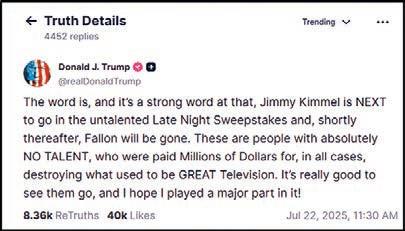


The Genius Act, they named it after me!
- Pres. Trump’s quip while signing the first major cryptocurrency legislation, called the Genius Act
We are arresting public security and national security threats all over this country.
– Ibid.
How dare you, sir? Would an untalented man be able to compose the following satirical witticism?
- Stephen Colbert addressing Pres. Trump, before proceeding to make the same stupid, unfunny jokes about Trump that caused him to lose his show in the first place
We are on the precipice of entering a censorship state in which Donald Trump is using the powers of the federal government in order to erase criticism from the airwaves. Stephen Colbert didn’t get fired because he wasn’t doing well.
– Sen. Chris Murphy (D-Conn)
So apparently, firing Stephen Colbert who made $20 million dollars a year while his show lost $50 million…was fascism. It’s not fascism; it’s math.
– Greg Gutfeld, Fox News
To the fact that CBS was losing millions yet kept him on the air is the very definition of propaganda.
– ibid.
To the left, everything is fascism, except actual fascism—like Cuba, Venezuela, China—all the places that Tim Walz and Bernie Sanders consider great honeymoon spots.
- ibid.
The Late Show lost $40 million last year, continuing a trend that has shown the program has not been profitable for some time.
Here are the numbers:
More than 100: The number of staffers working on Colbert’s program, including a band and an army of writers, producers, directors, and bookers.
$2.5 million: The amount each episode costs to produce the show nightly.
$130 million: The amount it costs annually to produce the show.
$20 million: Colbert’s reported annual salary.
2.4 million: The number of viewers watching Colbert’s show on average.
3.3 million: The number of viewers watching Gutfeld! hosted by Greg Gutfeld on Fox News, which has a fraction of the staff and resources Colbert has.
$40 million: The amount Colbert’s program has been losing annually.
- Washington Examiner
President Trump has made his position clear; this is personal for him. He considers Netanyahu a friend. I would say it’s extraordinary that the prime minister is on trial during wartime and during negotiations over hostages.
- U.S. Ambassador to Israel Mike Huckabee while appearing in court to support Prime Minister Netanyahu during his trial
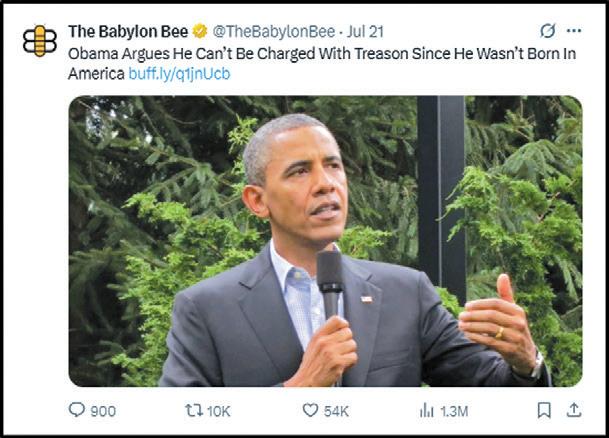

As a Jew, I will not lend a hand to the destruction of the Olam HaTorah. Our adherence to the mesorah, to the Torah, is what protected Am Yisrael throughout the years. That’s the basis of Am Yisrael. I’m saying this as a secular person, not as a Chareidi, not as someone who has a vested interest in the Chareidim.
- Likud MK Chanoch Milwidsky speaking in the Knesset
I don’t understand the members of Yesh Atid, National Unity, and Yisrael Beiteinu—how are you going along with this? How are your knees not trembling? How are you not frightened to fight against the very thing that protected Am Yisrael all these years?
- ibid.
And it’s not that we don’t need soldiers, but no soldier will help us if we break what unites and sustains us. And what unites and sustains us is Judaism. No Western value that people invented in the last 200 years will sustain us—only Toras Yisrael and Mesoras Yisrael that were conveyed to us from the Borei Olam.
- ibid.
A New York Times editorial claims that defunding NPR and PBS is like defunding the police. It’s true, think about all the times that you were assaulted and said, “If only the cast of Downtown Abbey was here.”
- Greg Gutfeld, Fox News
The Steven Miller Band has cancelled all of its tour dates because of “global warming.” Yep, organizers admit that it’s a waste of fuel to go all the way from Phoenix, Arizona, all the way to Tacoma, Philadelphia, Atlanta, L.A. - ibid.

Moderated by Jennifer Mann, LCSW of The Navidaters

My parents and I have different opinions on something, and we wanted to write into your column to hear the panel’s option it.
I’m a 23-year-old girl who’s been dating for three years. Thank G-d I have a lot of dates, just haven’t found the right one yet (hopefully soon!!). My parents often send shadchanim presents or something to show appreciation. Personally, I think that’s unnecessary. I try and encourage them not to do it... What if they think we are just kissing up to them? It seems disingenuous. My friends’ parents don’t do this.
What’s the right way to do it – is giving gifts appropriate or not?
Thanks, Rivka*
Disclaimer: This column is not intended to diagnose or otherwise conclude resolutions to any questions. Our intention is not to offer any definitive conclusions to any particular question, rather offer areas of exploration for the author and reader. Due to the nature of the column receiving only a short snapshot of an issue, without the benefit of an actual discussion, the panel’s role is to offer a range of possibilities. We hope to open up meaningful dialogue and individual exploration.
W E D D I N G P A C K A G E

Dear Readers,
We want to offer YOU an opportunity to be part of the discussion! Please email us at MichelleMondShadchan@gmail.com, subject line “reader’s response,” if you would like to participate in the new “A Reader’s Response” columnist spot. We will send you a question and publish your answer in an upcoming Navidaters edition.
If you have a question you would like the Navidaters to answer, please reach out to this email as well.
Looking forward!
Michelle, the “Shadchan”
Rebbetzin Faigie Horowitz, M.S.
Years ago, acknowledgment of the efforts of shadchanim was shown by parents largely only if a suggestion re -
sulted in a match. Today, there is much more understanding of the work involved in suggesting shidduchim; the time and energy are substantial. That’s why fewer people got involved until a lot of newer creative initiatives and data driven apps and databases were crafted to address the “shidduch crisis.” Also, with a larger Jewish community, the few shadchanim
around are bombarded with names of singles. Another complication is that these days, both parents and young adults tend to have a longer list of requirements and want people in their social circle, in their geographic communities, and in their specific Jewish culture. It makes it much harder to suggest shidduchim and people often find it way too time-consuming and hard. Fewer people are willing to invest the time to make suggestions.
People who feel valued and appreciated are more likely to go out of their way to reciprocate.
Your parents are showing that they know this takes time, effort, and persistence. They are being menschlech This is not like tipping a waitress who served you three meals over a Shabbos at a hotel. They are not being disingenuous. Why is it so difficult for you to understand this? No one owes you shidduch suggestions. It’s very kind when people do think of you. These people care about other Jews. Do you? The Shadchan
Mond
This does not happen often, but your question baffles me. Perhaps it’s be -








cause my love language is gifts. Showing appreciation for someone’s time and effort is one of the nicest things you can do! Throughout the Torah we read about the importance of giving gifts and showing appreciation.
My question for you is, what’s the source of your hesitancy? Are you generally more of a self-centered person? These are things I would like you to ask yourself. There is no logical reason to feel self-conscious about your parents giving gifts. It keeps you on their radar and makes them want to help you even more. When someone feels appreciated for their efforts, especially when it’s time-consuming, they have the fuel to
keep trying. Perhaps that is why you have gotten so many dates so far!
Think about it: being a shadchan is truly a thankless job. Shadchanim can spend countless hours networking, helping, and coaching, while setting you (and the young man) up. There is no such thing as showing too much appreciation. The fact that you feel gift-giving may be disingenuous leads me to believe that you may need to work on your middos and sense of bein adam l’chaveiro.
You are lucky to have your parents as parents; they are helping you in immeasurable ways.
The Navidaters
Dating and Relationship Coaches and
Dear Rivka,
This is such a thoughtful question, and I can already tell how much you’re trying to walk through dating with sincerity and self-awareness, which, by the way, is no small thing.
So first, I’m not a shadchan. That’s really not my lane. What I can do is help you explore what’s coming up for you around this.
There are so many reasons people give gifts. Sometimes it’s simply a heartfelt thank you, a way of acknowledging that someone took the time to think of you, make a call, or send your name in. Some people really appreciate that. Others feel awkward receiving anything. We don’t know how each individual shadchan feels. And I don’t think that when we act with kindness and a moral compass that we are responsible for other peoples’ feelings.
The trouble starts when gifts are used
to control, ma- nipulate, or obligate. That’s when things get murky. You know… “We gave you all these gifts and you barely think of our daughter.” Or, “Maybe if we give gifts, she’ll talk about what a generous family we are.” Or, “I spent so much time and effort picking out this gift for you, and you have the nerve to….” But when a gift is given from purity and good intention and pure hakaras hatov, I personally think it is a beautiful gesture.
It also sounds like part of what’s bothering you isn’t just the gift itself, but the fear of how it might be perceived, as disingenuous or strategic. I get that. It might help to ask yourself:
• Is this gift about gratitude, or is it trying to create an outcome?
• Is the discomfort coming from the gesture itself—or from worrying that someone will misread your family’s intentions?
Dr. Jeffrey
Galler
Has it occurred to you that the reason you are getting a lot of dates is because your parents are smart enough, and considerate enough, to show their appreciation to your shadchanim?
When you are generous to the shadchanim who are trying to help you, it helps keep you on their radar. It makes them more motivated to try and help you.
An appropriate token of appreciation is not simply a crass attempt at bribery; it is recognition of the fact that people who feel valued and appreciated are more likely to go out of their way to reciprocate.
I am sure that you have many outstanding attributes. May I respectfully suggest that you add the following to your existing list of wonderful qualities: Rivka is a very generous, thoughtful, considerate, and appreciative individual.
Esti
Ackerman Avid Navidaters’ Reader
As someone who has tried to set up shidduchim, sometimes b”H successfully, but more often than not, unsuccessfully, it can get very draining and frustrating. A little thank you gift from an appreciative parent not only gives me the chizuk to keep going, but it also helps me keep that single in mind. It’s also helpful for me to note if a parent is especially grateful vs. the opposite.
I don’t think there’s harm in sending gifts after a shadchan or friend tried setting you up. If your parents send gifts to shadchanim that never set you up, then that would be something I’d question. But if it’s after the fact, it’s probably the most appreciated concept for shadchanim who quite often suffer from burnout. There should be more parents like yours who show appreciation for the hardworking shadchanim!
• Is there another way you (or your parents) could say thank you that feels more aligned with your values?
How do you feel about receiving gifts when you show up for someone, whether personally or professionally?
If a gift is given with genuine appreciation, and it’s measured and appropriate, how it’s received really isn’t the giver’s responsibility. Not everyone will interpret it the same way, and that doesn’t make it wrong.
If I may share a personal little story… I will never forget the first time a client bought me a thank you gift. I was a younger therapist then, and I immediately brought this to the attention of several mentors. “You can’t keep that, Jennifer. It’s unethical to receive gifts from clients. It changes the dynamics of the relationship. You have to return it.” And others were of the camp of “that is so beautiful.
That person is touched by the work and the relationship and wants to show her gratitude through a symbol. Not accepting it would be a rejection of that gesture and change the safety of the relationship and… want to explore your ability to receive and connect?” Today, I have all sorts of doodads and knick-knacks around my office that were given as gifts, and I comfortably fall into the second camp. Some people say thank you with words, a look, a gift, and some people want to say thank you and don’t feel safe doing so.
At the end of the day, you know your heart. And it’s okay to want to express appreciation your way. You’re navigating this with so much grace and thoughtfulness, and I encourage you to keep exploring what gift giving is bringing up for you.
Warmly,
Jennifer Mann, LCSW
Jennifer Mann, LCSW is a licensed psychotherapist and certified trauma healing life coach, as well as a dating and relationship coach working with individuals, couples, and families in private practice at 123 Maple Avenue in Cedarhurst, NY. To set up a consultation or to ask questions, please call 718-908-0512. Visit www.thenavidaters.com for more information. If you would like to submit a dating or relationship question to the panel anonymously, please email JenniferMannLCSW@gmail.com. You can follow The Navidaters on FB and Instagram for dating and relationship advice.
By Rabbi Azriel Hauptman
The Torah (Devarim 24:5) teaches us, “When a man marries a new wife, he shall not go out with the army or be assigned to it for any purpose; he shall be exempt one year for the sake of his household, and he should give happiness to the woman he has married.”
The parameters of this Mitzvah (beyond a military exemption) is a dispute amongst the commentators, but we find a fascinating interpretation in the Sefer Yereim (Reb Eliezer of Metz, 1140-1237). He writes, “The Torah is teaching us that in the first year of one’s marriage, a man is obligated to give happiness to his wife in any way that he can make her happy.” According to the Yereim, whenever one does anything to make his wife happy during the first year of marriage, he is fulfilling a Mitzvah!
Why is it that in the first year of marriage, it is of primary importance to be laser-focused on providing Simcha to one’s spouse? Certainly, one should always try to make one’s spouse happy even after fifty years of marriage. It seems that the Torah is teaching us that during the first
In this article, we will delineate some of the challenges that make the first year of marriage potentially very difficult and that would explain why the first year of marriage requires extra-special care. Although we do not have space to offer solutions, sometimes just knowing that your problem is common gives you the strength to work it out.
Letdowns – Marriage is a world unto itself. There is no way to be fully informed about all that marriage entails until one actually takes the plunge. We have incredible Chasson and Kallah teachers that teach and inform about the nuances of marriage, but until the reality of marriage sets in, it may be hard to appreciate how surprising the realities of marriage can be. The sense of letdown that one may experience due to unrealistic expectations can lead to feelings of stress that can make the first year challenging.
Prior Friendships – Before marriage, one’s social life revolves around one’s friends. They go out together, vacation together, and spend a lot of quality time together. After marriage, although there is no need to sever one’s ties with friends,


time will invariably be with one’s spouse. Navigating the transformation of one’s relationships can be tricky and stressful.
Household Chores and Responsibilities – Once upon a time, the roles of men and women were clearly defined. The husband bore the responsibility of providing for the family, and the wife was the sole domestic engineer. It was not uncommon in those times for a husband to not know which cutlery were milchigs and which were fleishigs. This is not the case anymore. It may take time to figure out how to divide the household chores and responsibilities.
Money – It is very common for women to come into marriage with their own money that they earned in the years prior to marriage. How does one segue from financial independence to sharing one’s money? This is a minefield that needs to be traversed with care.
Parents and In-Laws – The Torah (Bereshis 2:24) tells us, “Hence a man leaves his father and mother and clings to his wife…” After marriage, relationships with parents change. How exactly they change differs from family to family. The transition may be painful for both the parents and the new couple.


Understanding Differences –No two people are alike and the more you get to know someone, the more you discover the differences. Similarly, when a husband and wife get to know each other, they will invariably discover their differences and all of their individual idiosyncrasies that are impossible to know about before marriage. Some of the differences are based on classic gender differences, and others are based on their different personalities. Reb Yisroel Salanter famously said that
it is easier to study the entire Shas in depth than to change one Middah. Just imagine what it must be like to change the Middos of another person! People will nevertheless attempt to change some aspect of their spouse. The shift from trying to change the differences to appreciating them may take some time.
Post-Wedding Blues – The period of engagement, preparation, and the actual wedding are exciting and exhilarating. Everyone is making a big fuss about you and you feel like you are on a cloud. Once all of the excitement is over, regular life sets in. The change in emotion from elation to plain life can be jarring and may lead to some level of minor depression, also known as “the blues”.
Sometimes, the challenges of marriage are even greater than described and sometimes the challenges involve mental illness. In such cases, professional help from an experienced clinician is often required.
Marriage does not make you happy automatically. Rather, you have to choose to bring happiness into the marriage. The dividends are immeasurable and your children will receive the greatest gift of allhappy parents who are happy with each other.
This is a service of Relief Resources. Relief is an organization that provides mental health referrals, education, and support to the frum community. Rabbi Yisrael Slansky is director of the Baltimore branch of Relief. He can be contacted at 410-448-8356 or at yslansky@reliefhelp.org
















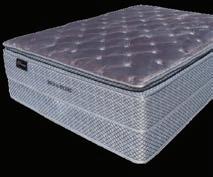
By Avi Heiligman


Israeli forces have been using a wide array of weapons and defensive systems during recent conflicts. These range from new aircraft and avionics to bombs that seal up tunnels to the Iron Beam. Since the Israeli War of Independence in 1948, innovators and engineers inside Israel have been looking for unique technology to enhance weapon systems. The list of inventions is quite impressive and has given Israel an advantage when fighting terrorists and hostile armies on the battlefield.
Even during the British Mandate, Jews were busy developing tactics and building weapons with whatever material was available. Barrel bombs made from oil drums were invented by the Irgun’s chief operating officer. Soon after Israel was established, IDF Major Uziel Gal designed one of the most famous submachine guns in history. Named after its inventor, the Uzi was lightweight (less than eight pounds) and had a folding open-bolt stock self-loading system. It became so popular that it was used by over 90 countries and over 10 million were produced.
The Israeli Air Force was hit hard following the French arms embargo on Israel right before the Six Day War in 1967. Dozens of aircraft needed to be replaced, and the 50 Mirage 5 jet fighters
that had been paid for by Israel were not going to be delivered by France. Alternative aircraft were needed by the IAF so Israeli engineers designed and built both the Nesher and Kfir fighter jets. The Kfir was introduced in 1975. Captain Shai Eshel was the only Israeli Kfir pilot to shoot down an enemy aircraft. On June 27, 1979, he shot down a Syrian MiG-21 with an air-to-air missile. The Nesher
on that was versatile and more accurate than previous anti-tank weapons systems. At least ten countries have used the B-300 at one time, and it has seen action in some of the Israeli wars against terrorist groups.
While anti-tank weapons were getting better, the IDF needed to protect their own tanks from sustaining devastating damage. The Trophy System was
Named after its inventor, the Uzi was lightweight (less than eight pounds) and had a folding open-bolt stock self-loading system.
was introduced in 1971 and saw success during the Yom Kippur War. The Israeli Air Force has claimed over a hundred kills of enemy aircraft in the Nesher.
Anti-tank weapons are often cumbersome to carry and weren’t always known for their accuracy. The Israeli-built B-300 was developed in the late 1970s as a reusable anti-tank weap -
developed by Rafael and first delivered to the IDF in 2010. It is an APS (Active Protection System) that to date is the only proven APS that has been battle tested. The Trophy System detects incoming threats by radar, tracks the angle and speed of the incoming threat, decides if the threat is high risk, and uses countermeasures to neutralize the
threat without damaging the vehicle. Not all threats are engaged by the system as it depends on a variety of factors and threat level. The Trophy System first saw action on the Gaza border in 2011 and is mounted on a variety of tanks and armored vehicles such as the Israeli Merkava tank and the American Abrams, Stryker and Bradley Fighting Vehicles. During Operation Protective Edge in 2014, the Trophy system was used dozens of times and not a single tank equipped with the system was lost. In the recent war in Gaza, the system was upgraded to detect and neutralize missile and drones. Thousands of incoming threats were stopped at an 85% interception rate.
Hamas spent many years digging tunnels underneath Gaza, and Israel has spent a lot of time, effort and money to destroy these tunnels once it has been verified that no hostages are inside. Blasting the tunnel with explosives and flooding them with seawater are just two of the methods used to prevent the tunnel from being used by Hamas and other terrorists in the future. Sponge bombs are another method developed by Israel to seal off the entrance of a tunnel. Instead of explosives, sponge bombs use chemicals that quickly expand and harden. The method reduces the risk of
collateral damage by not using explosives and effectively prevents the entrance from future use. The IDF has yet to confirm the usage of sponge bombs in Gaza, and they are possibly waiting for researchers to implement chemicals in the bombs that would not be dangerous for the soldiers if mishandled.
In addition to the battle tested Iron Dome all weather air defense system, Rafael also developed the Iron Beam – a direct energy air defense system. The Iron


ing projectiles. While it’s more cost effective to operate than the Iron Dome, the Iron Beam is not currently an all-weather system. The two systems are meant to operate in tandem and can shoot down threats that are too close for missiles to engage. While it is set to start operational deployment later in 2025, the IDF tested the Iron Beam system near the Gaza border under operational conditions. It was revealed by the IDF in May 2025 that a laser defense system, possibly the Iron
Beam, shot down 35 drones operated by Hezbollah. This is in addition to another report that the IDF used a laser defense system in the fall of 2024. It is very possible that laser defense systems have been used more extensively than is being revealed to the public.
Israel has always spent a lot of time and resources into ensuring that the IDF has the best equipment and systems available. The weapons and technology produced in Israel has been sold to countries across the globe, and partnerships


are constantly being formed as it is an economic benefit to Israel. Despite the costs of developing new weapons, these inventions have saved countless lives and will continue to do so in the future.
Avi Heiligman is a weekly contributor to The Jewish Home. He welcomes your comments and suggestions for future columns and can be reached at aviheiligman@gmail.com.





Parents possess a major role in creating stability for their child. One area we can focus on is ensuring parents communicate with each other and create a united front for their child. Sadly, too often, adults are unable to work together in ways that build and unite.
More than just creating stability, parental communication is a child’s first model for speech. They learn to speak from what they hear us say. Parents that frequently fight, chas v’shalom , raise children in a very different home from one in which adults respectfully discuss issues. Children repeat what they hear and experience in the world around them.
Communication is intended to bridge barriers and build relationships. Positive communication brings people closer, while negative speech drives others away. We want our children to have strong friendships, beautiful marriages and lasting connections. To be successful and happy in life, our children will need
By Sara Rayvych, MSEd

to learn appropriate communication.
Healthy communication demonstrates respect both for ourselves and each other. We respect ourselves when we express our needs, and we respect others when we listen and prioritize their feelings. Recognizing how speaking up for ourselves can bring us closer to others, as well as understanding the give-and-take in conversation, are a crucial, but often misunderstood, aspect of communication.
Like anything else in life, communication is a learned skill. The more we exercise effective communication, the better we become at it. We can give our children the best communication beginnings by modeling it ourselves whenever we speak.
There are many ways children will require communication skills. This is one of those lessons that will be useful today and everyday throughout their lives.
Being able to advocate for themselves and state their physical needs is important.
It was a busy morning getting ready for the class play, and the teacher couldn’t focus when her young student said she wasn’t feeling well. The unwell child got caught up in the excitement and pushed aside her personal concerns. It would be hours later before someone heard the child’s need, but by then, he required hospitalization.
It’s clear that children need the ability to speak up about their needs. Children may be thirsty, hungry or simply not know where the bathroom is. Perhaps they are lost, chas v’shalom , and need help. There are any number of physical needs that a child will require verbal skills to meet.
Being heard is also an emotional need. Children, like adults, need to share what concerns them. Perhaps someone is bullying them or they’re experiencing emotional challenges. We
need to not only make ourselves available to them; they also have to be capable of expressing their feelings when given the chance.
Children have to understand the difference between the beautiful middah of being mevater, and the negative passivity of denying their own necessities. We don’t want children to be unable to speak up because they’re afraid or don’t value themselves.
Communication is the foundation of relationships. Building and maintaining any relationship requires a strong foundation in effective communication. This applies in friendship, business and all interactions. Most importantly, they will use these skills in their own marriages. Growing up in an environment that models effective communication is the simplest way to pass these skills on to the next generation.
Learning to Disagree
Fighting is different from disagree -
ing. In this article, I am defining “disagreement” as “the respectful exchange of differing opinions.” If it’s not respectful, then it’s fighting. For example, one couple can calmly discuss an upcoming vacation period, weighing the options and each giving over their feelings and concerns. Another couple without effective communication could argue over each point, with neither feeling heard but plenty of hurt feelings being shared.
Disagreeing with another person is normal and healthy. We each have our own needs and perspectives – it’s only natural they will differ from another person. Best friends may have a lot in common, but they will always have some differences. Even identical twins who share DNA will not share all the same opinions.
A surprising number of children and adults are afraid or hesitant to disagree with another person. This can be for a number of reasons, including not feeling their own needs are valid or a fear of confrontation. It’s crucial that children learn how to properly express their own needs.
While ideally parents never fight, it’s important to certainly never do it
where children can hear or see it. Minor disagreeing can be an exception to this rule if parents are certain it will remain respectful and productive. As children learn from the environment around them, it’s educational to see how adults can disagree but maintain respect for each other. Children don’t intuitively
education and natural development to help our sweet youngsters begin to see beyond themselves and respect the differing views of those around them. This, too, we can model in our communications when we show understanding and sensitivity to the opinions of others, especially when we disagree.
We can give our children the best communication beginnings by modeling it ourselves whenever we speak.
understand how to have a healthy giveand-take in a conversation. This is an area we certainly need to model for our children.
Children are adorable and innocent, and their undeveloped minds are often incapable of seeing things from another’s perspective. In their young brains, their way is the only correct way. It takes
Validation is accepting another person’s needs, opinions and feelings as valid – even if we don’t personally agree with them. For example, I may not find something hurtful, but I can understand that someone else may feel hurt by those same words. By understanding their feelings – from their perspective – I can validate their painful emotions. We can train ourselves to validate the feelings of our children and others when
we communicate. This skill is even more crucial when we disagree with someone.
Part of the beauty of parenthood is having the opportunity to acquire the skills we never mastered when we were young. As parents, we may need to brush up on the parts of communication that we are weak in. It’s never too late to learn, and the benefits will be exponentially better as we can pass on our newfound techniques to our children. There are many books available, as well as mental health professionals that are skilled in training others in these techniques.
We have the privilege and responsibility to teach our children the skills they will use throughout their life. Modeling healthy communication will not only start our children on the best path, it will improve our own, too.
Sara Rayvych, MSEd, has her master’s in general and special education. She has been homeschooling for over 10 years in Far Rockaway. She can be contacted at RayvychHomeschool@gmail.com.

Aryeh & Chana Sobol on the birth of a daughter
Moshe & Ariella Pifko on the birth of a son
Moishy & Atara Schwartzberg on the birth of a daughter
Yehuda & Bassie Shnidman on the birth of a daughter
Jonny & Racheli Rosenblum on the birth of a daughter
Avi & Tehila Safren on the birth of a son
Mr. & Mrs. Binyamin "BB" Bakaev on the birth of a daughter







































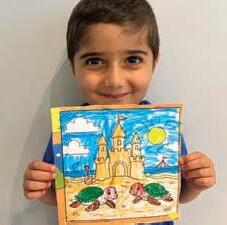
Note: Not all submission have been published. Keep sending in your artwork for another chance to be featured!

























Note: Not all submission have been published. Keep sending in your artwork for another chance to be featured!

By Naomi Nachman
I am visiting my parents in Australia, and my mum and I love cooking together. I had asked her for a parve recipe for the Nine Days, and she suggested we make this new recipe she had recently tried that she had seen in a local magazine. I absolutely loved this recipe, and I knew had to share it with our readers.
◦ 8 Cremini mushrooms, sliced
◦ 2 baby bok choy, sliced
◦ 1 onion, diced
◦ 1 cup Chinese cabbage (or your favorite preferred cabbage)
◦ 2 large scallions, chopped
◦ 3-4 cloves crushed garlic
◦ 1 tsp toasted or roasted sesame oil
◦ 1 tbsp soy sauce
◦ 2 eggs
◦ ½ cup self-rising flour
◦ 1 tsp kosher salt

Mix all ingredients together. Adjust and taste seasonings to your liking. (You should have about 3 cups of vegetables before adding in everything else.)
Working in batches, slightly wet your hands and form 2-inch patties.
Fry patties on medium-high heat till brown on each side.
Serve with spicy mayonnaise.
Naomi Nachman, the owner of The Aussie Gourmet, caters weekly and Shabbat/ Yom Tov meals for families and individuals within The Five Towns and neighboring communities, with a specialty in Pesach catering. Naomi is a contributing editor to this paper and also produces and hosts her own weekly radio show on the Nachum Segal Network stream called “A Table for Two with Naomi Nachman.” Naomi gives cooking presentations for organizations and private groups throughout the New York/New Jersey Metropolitan area. In addition, Naomi has been a guest host on the QVC TV network and has been featured in cookbooks, magazines as well as other media covering topics related to cuisine preparation and personal chefs. To obtain additional recipes, join The Aussie Gourmet on Facebook or visit Naomi’s blog. Naomi can be reached through her website, www.theaussiegourmet.com or at (516) 295-9669.
410.775.5440 | amfcreative.com
An Evening of Tribute in Honor of the Yartzait of
WEDNESDAY, JULY 30 | 8:00 PM DOUBLETREE BY HILTON – PIKESVILLE 1726 REISTERSTOWN ROAD
A Groundbreaking New Initiative in Miriam’s Honor
Separate seating for men and women Advance RSVP is appreciated at www.MiriamsLegacy.org


RABBI SHAIS TAUB
Keynote speaker
RABBI YONASON SEIDEMANN Rav Kehilas B’nai Torah
RABBI YECHEZKEL ZWEIG Menahel, Bais Yaakov High School